2020ENGINEERING DIMENSIONS

ALSO INSIDE:
u Certificate of authorization renewals go online
u Engineering salary survey findings
u Security solutions for digital engineering documents


ALSO INSIDE:
u Certificate of authorization renewals go online
u Engineering salary survey findings
u Security solutions for digital engineering documents
April 19–25, 2020
In honour of National Volunteer Week, PEO recognizes and thanks our volunteers, including those who serve on Council, committees and their subcommittees, task forces and the Government Liaison Program; and PEO chapter leaders and volunteers, as well as those who represent PEO on external boards and advisory groups and participate in chaptersponsored programs.


ASSOCIATION BUSINESS
5 Editor’s Note
6 President’s Message
7 CEO/Registrar’s Report
23 Notice of 2020 Annual General Meeting
35 GLP Journal: Engaging members in government relations
36 In Council
NEWS AND COMMENTARY
8 PEO’s certificate of authorization renewal process goes online; Engineering salaries: How much should you be paid?; Engineers Canada reports growth in national engineering numbers; Consulting engineers urge Liberal government to address infrastructure concerns; PEO honours 12 through 2020 Order of Honour Awards; Voluntary PEAK program operationalized; Manitoba regulator seeks updates to limitations act; Engineers Canada approves new white paper on environmental engineering
32 Bulletin Board
33 Awards
38 Letters
PROFESSIONAL ISSUES
21 Professional Practice: Commonly asked questions about digital engineering documents
ADVERTISING FEATURES 37 Professional Directory 38 Ad Index

DIGITAL EDITION
Read Engineering Dimensions from anywhere! Visit engineeringdimensions.ca to read our current digital edition, view issue archives, print and share articles and download the magazine as a PDF document.
COVER 8 Certificate of authorization renewals go online
9 Engineering salary survey findings
21 Security solutions for digital engineering documents
PUBLICATIONS STAFF
Editor Nicole Axworthy editor@peo.on.ca
Associate editor
Marika Bigongiari
Associate editor
Adam Sidsworth
Senior graphic designer
Stephanie Katchmar
Graphic designer
Cindy Reichle
Manager, communications
Duff McCutcheon
Digital communications coordinator
Michelle Yiu
ADVERTISING SALES
Manager, sales
Beth Kukkonen bkukkonen@dvtail.com
Dovetail Communications
30 East Beaver Creek Road
Suite 202
Richmond Hill, ON L4B 1J2
Tel: 905-886-6640
Fax: 905-886-6615
EXECUTIVE STAFF
CEO/Registrar
Johnny Zuccon, P.Eng., FEC registrar@peo.on.ca
Deputy registrar, licensing and registration
Vacant
Deputy registrar, regulatory compliance
Linda Latham, P.Eng.
Deputy registrar, tribunals and regulatory affairs
Johnny Zuccon, P.Eng., FEC
Chief Administrative Officer
Vacant
Director, communications
David Smith
Director, finance
Chetan Mehta, MS, MBA Director, information technology
Michelle Wehrle
PEO COUNCIL
Officers
President
Nancy Hill, P.Eng., LLB, FEC, FCAE president@peo.on.ca
Past President
David Brown, P.Eng., FEC, BDS, C.E.T., IntPE, MCSCE
President-elect
Marisa Sterling, P.Eng., FEC
Vice president (elected)
Christian Bellini, P.Eng., FEC
Vice president (appointed)
Iretomiwa Olukiyesi, P.Eng.
Executive Members
Sandra Ausma, PhD, P.Eng.
Lorne Cutler, MBA, P.Eng.
Leila Notash, PhD, P.Eng., FEC
Warren Turnbull, P.Eng., FEC
Councillors
Councillors-at-large
Gregory Wowchuk, P.Eng.
Sandra Ausma, PhD, P.Eng.
Leila Notash, PhD, P.Eng., FEC
Northern Region councillors
Ramesh Subramanian, PhD, P.Eng., FEC
Serge Robert, P.Eng., FEC
Eastern Region councillors
Guy Boone, P.Eng., FEC
Randy Walker, P.Eng.
East Central Region councillors
Keivan Torabi, PhD, P.Eng.
Arthur Sinclair, P.Eng.
Western Region councillors
Gary Houghton, P.Eng., FEC
Wayne Kershaw, P.Eng., FEC
West Central Region councillors
Lisa MacCumber, P.Eng., FEC
Warren Turnbull, P.Eng., FEC
Lieutenant governor-in-council appointees
Arjan Arenja, MBA, P.Eng.
Robert Brunet, P.Eng.
Lorne Cutler, MBA, P.Eng.
Qadira C. Jackson Kouakou, BA, BSW, LLB
Iretomiwa Olukiyesi, P.Eng.
Nadine Rush, C.E.T.
Marilyn Spink, P.Eng.
Sherlock Sung
Engineers Canada Directors
Annette Bergeron, P.Eng., FEC
Christian Bellini, P.Eng., FEC
Danny Chui, P.Eng., FEC
Kelly Reid, P.Eng., IACCM CCMP
Changiz Sadr, P.Eng., FEC
Engineering Dimensions (ISSN 0227-5147) is published bimonthly by the Association of Professional Engineers of Ontario and is distributed to all PEO licensed professional engineers.
Engineering Dimensions publishes articles on association business and professional topics of interest to the professional engineer. The magazine’s content does not necessarily reflect the opinion or policy of the Council of the association, nor does the association assume any responsibility for unsolicited manuscripts and art. All material is copyright. Permission to reprint editorial copy or graphics should be requested from the editor.
Address all communications to The Editor, Engineering Dimensions, PEO, 40 Sheppard Avenue West, Suite 101, Toronto, ON M2N 6K9. Tel: 800-339-3716.
Engineering Dimensions is a member of Canadian Business Press.
Indexed by the Canadian Business Index and available online in the Canadian Business and Current Affairs Database.
US POSTMASTER: Send address changes to Engineering Dimensions, P.O. Box 1042, Niagara Falls, NY, 14304.
CANADA POST: Send address changes to 40 Sheppard Avenue West, Suite 101, Toronto, ON, M2N 6K9.
Canada Publications Mail Product Sales Agreement No. 40063309. Printed in Canada by Renaissance Printing Inc.
SUBSCRIPTIONS (Non-members)
Canada (6 issues) $33.90 incl. HST
Other (6 issues) $40.00
Students (6 issues) $16.95 incl. HST
Single copy $4.50 incl. HST
Visit: peo.on.ca/about-peo/engineering-dimensions
Approximately $5.00 from each membership fee is allocated to Engineering Dimensions and is non-deductible.
Recyclable where facilities exist
CONNECT WITH US Web: peo.on.ca Tel: 800-339-3716
twitter.com/PEO_HQ linkedin.com/company/peo---professional-engineers-ontario facebook.com/ProfessionalEngineersOntario
By Nicole Axworthy
To protect the public, PEO investigates all complaints about unlicensed individuals or companies, and unprofessional, inadequate or incompetent engineers. If you have concerns about the work of an engineer, fill out a Complaint Form found on PEO’s website and email it to complaints@peo.on.ca. If you suspect a person or company is practising engineering without a licence, contact PEO’s enforcement hotline at 800-339-3716, ext. 1444, or by email at

Sustainability is more than just a buzzword. It’s a crucial concept that has become relevant in nearly every sector of society. When we hear the word “sustainability,” we tend to think of reducing carbon emissions, transitioning to renewable fuel sources and cleaning up and protecting our natural environment from the damage we’ve already done. It has become one of the world’s greatest challenges, and engineers are increasingly expected to play leadership roles when it comes to sustainable development. Engineers are working to solve the numerous ecological challenges that come along with widespread pollution, resource depletion, rising human population and multiple threats to food, water and energy securities—all of which require a tremendous shift in engineering thinking and the way in which we find and test solutions while also driving innovation. This isn’t the first time we’ve discussed the environment and sustainability within these pages, nor will it be the last. The challenges and opportunities are endless. We can’t begin to scratch the surface in a single issue of Engineering Dimensions, but with the plethora of information out there on the importance of sustainability for our continued future on this planet, one thing is for sure: renewable energy and sustainable infrastructure are essential components to consider. And the role engineers play in these sectors is vital.

In “Engineers weigh in on the shift to renewable energy” (p. 24), Associate Editor Marika Bigongiari consults with three engineering professionals who are dedicating their careers to shifting Ontario to renewable energy sources. From the controversial process of reducing emissions by capturing and storing carbon to the environmental considerations of our decades-old hydropower dams, cleaner energy options are the way of the future. And in “Engineers tackle building sector carbon emissions, one condo at a time” (p. 28), Associate Editor Adam Sidsworth takes us on a journey through the development of Toronto’s and Hamilton’s high-rise residential buildings, which, shockingly, generate nearly half of the area’s environmentally damaging carbon emissions. With more and taller new builds being constructed every year, we find out what engineers are doing to make them more sustainable.
At this time of year, we’re focused on planning PEO’s upcoming annual general meeting, Volunteer Leadership Conference and Order of Honour Awards ceremony (p. 15). This year, the events will take place on April 24 and 25 in Ottawa, Ontario, and we hope you’ll join us. Find more information at peo.on.ca.
And finally, I’d like to thank you for completing our recent Engineering Dimensions reader survey. Knowing how you feel about the mix of topics we cover is essential to the continued evolution of the magazine. e
We explore how Ontario engineers are creating innovative solutions to reduce our carbon footprint while producing environmentally friendly energy infrastructure. And we look at how engineers are reducing buildings’ carbon emissions with sometimes simple solutions.
By Nancy Hill, P.Eng., LLB, FEC, FCAE
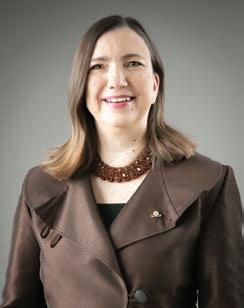
As I wind down my term as PEO president, I would like to use my last president’s message to express my thanks for the opportunity to serve the regulator and the profession in this role over the past year. As PEO nears a century of regulating the profession, 2019 was arguably a watershed time in our history and Council took several important steps to help ensure the regulator remains relevant into its next century. I want to thank everyone who contributed to, and supported, this work.
Near the beginning of my term, in 2019, we received the results of PEO’s external regulatory performance review, which pointed out some serious shortcomings in how we regulate engineering in Ontario. The review also provided a way forward: 15 recommendations that should help chart a path for renewal and improve PEO’s regulatory performance.
Council accepted the report in its entirety and has since approved an action plan to address the recommendations. Implementing these recommendations will require both staff capacity and strong, focused leadership and governance from Council. And as I noted in my first president’s message, our governance structure—how PEO oversees itself and sets strategies and priorities—requires thoughtful renewal and change (“Facing our biggest challenges,” Engineering Dimensions, May/June 2019, p. 6).
Council began work on enhancing its governance at its June 2019 workshop, where we explored governance issues, including clarity about the role of PEO vis á vis the public interest; the role of regulators versus associations; and the roles of Council, the CEO/registrar and staff (policy versus operation). We also discussed what kind of Council we need to be: one focused on oversight and advisory roles that sets goals for the organization and oversees performance.
To help guide us in our oversight role, we committed to engaging a governance advisor to assist with developing sound governance and leadership practices and ensuring we continue to act in the public interest. And in September, we retained Governance Solutions Inc. (GSI) to fill this role. GSI is an internationally known corporate governance advisor with over 28 years of experience in providing governance solutions. Since last fall, GSI has attended all Council meetings, coaching us to enhance our governance culture and practices; clarifying roles and responsibilities; and providing guidance around agenda creation, priority setting and ensuring we maintain an appropriate public
interest focus. They have also provided ongoing governance training for Council, the Executive Committee and myself, and acted as a parliamentarian during Council meetings to ensure rules of order are followed and to assist me in my role as chair. GSI also had Council undertake an online self-assessment to provide a baseline diagnostic assessment of our governance performance. The results were presented to the Executive Committee in January and shared with Council at its plenary session in February, along with a roadmap highlighting recommended key steps to help build and maintain our governance effectiveness.
Bolstering Council’s governance in tandem with our work building PEO’s regulatory performance is important if we’re to meet the external review recommendations. As the governing body, Council needs to be prepared to look objectively and critically at what we’re doing and ask if we’re doing the best we can and how we can make it better. The status quo—continuing to do things the way we had—is not good enough. It is important that we function as an oversight board and that we leave operations to the CEO/registrar and staff. I’m confident that our progress, under the tutelage of GSI, will result in a modernized Council that’s focused on high-level strategy, guiding PEO as a regulatory leader.
Ultimately, we don’t have any other options if we’re to remain relevant and able to change with the times. Engineering is advancing exponentially, with new disciplines and technologies emerging regularly. And as the external regulatory performance review made clear, we’ve got some catching up to do if we’re going to effectively regulate the full gamut of engineering in this province. A strong, appropriately focused Council is key to building a PEO that’s up to the task of regulating modern engineering. By the time this issue is in your hands, it’s likely that Council has already made an important decision at its March meeting regarding our path forward with governance. I am hopeful that Council embraces the roadmap that GSI has prepared for us. If we don’t, in my opinion, we will be left behind.
At the end of the day, it’s about not being afraid to change. e
By Johnny Zuccon, P.Eng., FEC

In my inaugural column in the last issue, I shared the three expansive and transformational paths on which PEO has embarked:
• Operational,
• Organizational, and
• Governance.
This time, I’d like to focus on what I consider to be the most critical step of our operational path—the activity filter. The filter is a key component of the Council-approved action plan to address the recommendations in PEO’s external regulatory performance review, informally called the Cayton report.
At its November 2019 meeting, Council approved this staff-developed tool to classify the activities and corresponding outputs of PEO committees, task forces, working groups and chapters, with an aim of ensuring that all change initiatives are collectively and appropriately aligned.
At its subsequent meeting in February, Council received a progress report on staff’s application of the filter. Following a vetting process to eliminate duplicate activities or those with no discernable or measurable outputs, staff had compiled a list of 93 distinct activities and outputs. Each activity and related output(s) were classified using the Council-approved process and criteria—specifically, if they are regulatory, related to governance or neither. Of the 93 activities and outputs, 40 were classified as regulatory (including 20 as core regulatory activities and 20 as regulatory policy activities), 18 were related to governance and 35 were classified as neither. This classification completes the second phase of the activity filter’s five-phase process as illustrated in the graphic below.
The results of the activity filter show that our core regulatory activities are a mix of those that are required and permitted; numerous committees and task forces provide policy input in regulatory areas; governance activities are scattered amongst a few committees; and the “neither” classification group is large and very diverse.
Having completed the approval and classification phases, we move on to the evaluation phase (Phase 3). This involves a careful analysis of the activities and corresponding outputs measured against their legal requirements. Then, in Phase 4, determinations must be made on who is accountable for the outputs (i.e. either Council or the CEO/registrar). Lastly, a reporting system must be developed (Phase 5). For activities with outputs that fall within the CEO/registrar’s domain, staff will develop appropriate reporting metrics. For other activities, staff will provide recommendations to Council to enable it to perform its oversight functions associated with direction and control.
The filtering of activities and outputs isn’t the end of a process—in fact, it’s just the beginning. This process, combined with our organizational review and governance enhancements, are immediately critical to our transformation. There is a lot happening all at once, involving all levels of PEO and all functions. We’re in the midst of a profound undertaking…an unprecedented undertaking. But, with time, talent and trust, we will reach our change vision of becoming a professional, modern regulator that delivers on its statutory mandate and is supported by a governance culture that consistently makes decisions that serve and protect the public interest. e
By Marika Bigongiari
PEO’s information technology (IT) department has taken a big step forward in modernizing its licensing processes by making online renewals of certificates of authorization (C of A) possible. Led by Faris Georgis, P.Eng., manager, registration, the completion of the C of A online renewal project is the first of many initiatives to move PEO services online and marks a big shift in how things have historically been done. “This digitalization and automation project was a wonderful collaboration effort between PEO IT, communications, finance, policy and registration staff, as well as 26 engineering companies who assisted by being part of the pilot project,” Georgis says. “The result was a project completed on schedule and implemented smoothly with positive feedback from the companies.”
Based on user feedback, the old process—which was a paper-based method—was frustrating to engineering company representatives because they were often resubmitting the same information by mail year after year. With the new online process, information from the previous year’s application automatically populates the requisite fields, and now users only need to make changes if necessary and press the submit button. “It’s a big time-saver for all involved, staff and users alike,” Senior IT Project Manager Paula Habas says. “We designed the renewal to be as easy as possible to complete. All the data from previous applications is now available for the user. They just need to update a few items and submit. They can also pay by credit card online. After they submit their application, it will be reviewed and, upon approval, a summary will be made available in our portal along with their payment receipt. It’s that easy.”
C of A holders must still submit their application during their renewal period, which is 60 days before their C of A licence expires or after they receive an email renewal notice from PEO. However, they can now make changes to their application at any time during the year and save that information to the system to further simplify the process come renewal time.
In addition to making it more convenient for C of A applicants, the new online self-service model will:
• Reduce time spent renewing an application;
• Immediately identify inconsistencies or missing information, reducing the need to resubmit follow-up information;
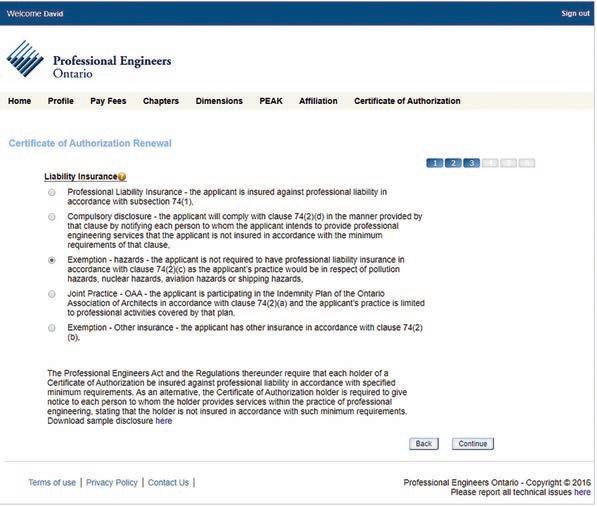
• • Other process improvements include automations such as email dispatches at various critical points of the process to warn of a payment submitted without an application, for example, or an imminent C of A expiry or closure of a renewal application. Additionally, all responsible licence holders listed on a C of A application will be sent an email notifying them that their name has been added to the C of A and that they are assuming responsibility for the engineering services provided by the C of A. Users can download receipts along with a summary of the year’s application information via the PEO online portal (secure.peo.on.ca/ebusiness/home).
In transforming the current C of A renewal process from a paper-based process to an online renewal solution, the project team had several objectives, one of which was giving C of A renewal applicants the ability and responsibility to manage their own applications online. Another objective was providing online payment options for C of A renewals, thereby reducing the reliance on cheques and internal cheque processing. The project team also wanted to improve efficiency of the C of A licensing process by eliminating time-consuming tasks such as printing and mailing renewal applications and the need to manually enter data from paper applications into PEO’s system and filing documents. Further benefits include reducing the costs of administering C of A renewals by eliminating paper applications, as well as reducing the amount of physical space required for C of A renewal files. Habas points out that no longer having to print, stuff and mail renewals, default notices and termination letters or manually input data will result in freeing up a significant amount of PEO staff’s time, allowing them to shift their focus to more important tasks.
By Liz Elliot
Ready to apply for that new job? Or prepping for your annual review? Most of us have asked at some point, “How much should I be paid?” The correct answer to this question is much more complex than employees might realize. There are three main perspectives to consider: the company perspective, the external perspective and the employee perspective.
The company perspective is focused on financial standing and profitability: What does this job or role mean to the organization and its ability to achieve long-term goals or run the day-to-day business? An organization makes efforts to preserve the internal equity of the job to keep positions in the correct pecking order.
The external perspective refers to the market rate for the position: What are competitors paying? Who does the company view as its peer group? What supply of talent is available for a particular job? This data is rather firm but still allows for subjective adjustments.
Lastly and most familiar is the employee perspective: What is your time and effort worth to you? Money isn’t always the
most significant form of reward an employee can receive, but cash is still king. The 2019 Mercer Global Talent Trends Study continues to report, “Pay me more,” is still at the top of the list of employee requests.
These perspectives provide a general idea of how pay ranges are determined; however, as mentioned above, the market section and source you choose impact what the job is worth. For years, an engineer’s compensation has been evaluated using provincial engineering classification guides. In Ontario, we know this guide to be the Classification Guide of Engineering Responsibility Levels, which defines Levels A to F as a career progression defined by increasing duties, decision making, leadership, authority and qualifications. But beyond the defined responsibilities of these levels, what are other fundamental drivers of engineering compensation? The 2019 Mercer OSPE National Engineering Compensation Survey—produced by Mercer and the Ontario Society of Professional Engineers (OSPE)—aimed to find out. continued on p. 10

Figure 1: Average base salary, total cash and total direct compensation by industry super sector for all engineering levels combined
All levels combined base salary, total cash and total direct compensation by super sector
Figure 2: Base salaries at the Level P3/Level C across engineering sectors
continued from p. 9
PAY IS IN THE DETAILS Industry
The industry that you work in sets not only the stage for how much your total compensation is but what types of reward you receive. In addition to base salary, your total compensation includes any shortterm incentives (STIs)—often referred to as bonuses—and long-term incentives (LTIs). Depending on the business models, various industries apply these compensation levers differently. Commodity-based industries such as energy and mining tend to rely on STIs and LTIs more than other industries. Some industries have a higher prevalence of public or private companies, which can also influence the proportions of STIs and LTIs.
Engineers typically enjoy a pay premium over other professions but holding specialized skills can attract even higher premiums. However, for two
engineers in the same discipline at the same level, the jobs that they perform and the skills required can be very different, and their contribution or internal equity to the organization can vary.
If we look at the P3 Level / C Level (mid-career and senior level positions) across multiple engineering specializations, we see a differential of up to $40,000 on base salary (see Figure 2). The highest paid base salary reported in the Mercer OSPE National Engineering Survey Central Region (Ontario) is for chemical engineering.
Location
Location, location, location—we’ve heard it before. Because engineers are employed across various industries, they can be deployed all over the world
to either dense and populated settings or to remote work sites. The cost of living and quality of life are major considerations when setting pay levels. Location also determines what a company’s local talent pool looks like and whether the cost of relocation is competitive to motivate employees.
Even looking within Ontario, we see wage variance by location. As seen in Figure 3, civil/ construction/structural engineers at the Level P3 / Level C have considerably higher base salaries in the Greater Toronto region than in eastern Ontario.
Pay-for-performance is a common topic in human resources, but what exactly does it mean for you? According to our data, 67 per cent of participating companies have a performance rating system. Although company performance can drive STI and LTI values, individual performance metrics are the most common, with 95 per cent of companies using it to determine base salaries. Having clear performance expectations and ratings promotes alignment of employee and employer efforts, provides effective motivation and ensures that employees who work hard and are good at their jobs are properly rewarded.
Many organizations use a payfor-performance approach when providing salary increases and rewarding high performers with greater than average salary increases. More than half
$80,000
$60,000
$40,000
$20,000
$0
(63 per cent) of organizations differentiate performance using a four or five-level rating system (see Figure 4).
Determining Base Salary Increase (N=79)
Measures Determing Annual Bonus (N=71)
The Mercer OSPE National Engineering Compensation Survey strives to establish meaningful criteria for engineering pay levels for the benefit of both engineers and employers. In 2019, the data collected from 413 private and public organizations provided compensation and workforce metrics data for over 48,000 engineers, technicians and technologists nationally, across 12 responsibility levels and 287 specializations. OSPE members can access the Member Market Summary Report as part of their OSPE membership. Employers can order the full 2019 Mercer OSPE National Engineering Compensation Survey by contacting Mercer at imercer.com/engineering, 800-333-3070, or info.services@mercer.com.
Liz Elliott is the industry relationship manager for Canadian energy and North America mining for Mercer’s Workforce Products.
By Adam Sidsworth

Engineers Canada released its 2019 National Membership Report of all engineering regulators’ membership numbers from across Canada, using data from the 2018 calendar year. According to the report, there were a total of 302,876 licensed engineers across Canada, an increase of 2.3 per cent from 2017. The largest growth by shear numbers was in Ontario (2610) and Quebec (1511), followed by British Columbia (1269); the territories experienced the largest percentage increase, with Yukon membership increasing by 11.6 per cent and the Northwest Territories by 7.9 per cent.
The provinces that saw the largest number of women receiving their engineering licences in 2018 were Ontario (471), followed by Quebec (385) and Alberta (238). Despite the seemingly low numbers of women receiving their licences in 2018, regulators saw a larger percentage increase—5.5 per cent nationally—of women than men, who experienced just a 1.9 per cent increase. As of 2018, women now account for 18.1 per cent (less than one in five) of newly licensed engineers in Canada. This is notable given the participation of all of Canada’s engineering regulators in the Engineers Canada–led 30 by 30 initiative, which aims to have women representing 30 per cent of newly licensed engineers by 2030.
In 2018, there were 172,391 practising engineers licensed in the jurisdiction in which they resided. Prince Edward Island had the largest percentage of its licensed engineers living within the province (99.3 per cent), while Yukon was at the
opposite end of the spectrum (16.5 per cent). Only 13.6 per cent of engineers licensed in Canada were licensed outside the province or territory in which they lived, while 3.9 per cent of engineers lived abroad. Interestingly, women engineers were slightly more likely to live where they were licensed (87.8 per cent) than men engineers (81.6 per cent).
ENGINEERS PER 1000 PEOPLE
Prince Edward Island had the lowest per capita of engineers within its jurisdiction, with just 1.9 engineers per 1000 people. Alberta had the highest, at 8.9 engineers per 1000 people. Ontario had the third-highest per capita, with 4.1 engineers per 1000 people. (Aside from Alberta, only Quebec had a higher per capita, with 5.3 engineers per 1000 people.)
ONTARIO’S NUMBERS
Engineering Dimensions reported on PEO’s 2018 licensing numbers in more detail in early 2019 (see “2018 a record year for new engineering licences,” Engineering Dimensions, March/April 2019, p. 15). In 2018, PEO issued 2649 licences, a 19 per cent increase from 2017 and a 41 per cent increase from 2016. Also, 2018 witnessed 5842 applications for licences, continuing a typical 5 per cent increase in applications throughout the previous 10 years.
By Adam Sidsworth
In light of the re-election of the Liberal federal government, the Association of Consulting Engineering Companies (ACEC) is urging the government to speed up its infrastructure spending and more clearly define its new environmental protec tion laws.

ACEC’s first concern is C-69, An Act to Enact the Impact Assessment Act and the Canadian Energy Regulator Act, to Amend the Navigation Protection Act and to Make Consequential Amendments to Other Acts, which was passed last June. The act repeals the Canadian Environmental Assessment Act and replaces the National Energy Board with the Canadian Energy Regulator (CER). It also transfers the responsibility to assess the impacts of environmentally sensitive energy projects to the newly created Impact Assessment Agency of Canada (IAAC). The IAAC will, among other things, lead all federal reviews of major projects and work with federal agencies, including the CER, the Canadian Nuclear Safety Commission and Offshore Boards, in co-operation with the provinces and territories and indigenous jurisdictions. With this new act, projects that pose significant risks to the environment in areas under federal jurisdiction are now subject to additional impact assessments, but ACEC says the new rules lack clarity.
“C-69 has 20-plus impact factors that need to be considered,” asserts John Gamble, P.Eng., C.E.T., president and CEO of ACEC. For example, the government’s impact assessment must now consider projects using Gender-based Analysis Plus, an analytical tool used to assess how diverse groups of women, men and genderdiverse people experience policies and programs. “I’d like to believe there’s nothing there that we’re against, but we need clarity about what these impact factors are and what they mean,“ Gamble says. “They haven’t demonstrated them yet.” Gamble fears that the government’s lack of clarity may negatively impact the ability










adverse environmental effects rather than promoting sustainability; timelines lacked flexibility; and indigenous involvement was minimalized.
According to the federal government’s Better Rules for Major Project Reviews handbook, C-69 introduces continued on p. 14 of project proponents to make sound business decisions. “I think the apprehension in the legislation is that the government has told us that the clarity will be in the regulations,” Gamble says. “And that very well may be, but in the meantime, we have to make informed business decisions.”
Gamble notes that ACEC was involved in and spoke at the public consultations while C-69 navigated the legislative process, urging the government to have public hearings on the impact factors. Should the government choose not to go that route, Gamble notes that “we intend to engage with the government to make sure that each of these impact factors are addressed.” Nonetheless, Gamble says he recognizes the need for change, as “the status quo pre-C-69 was not particularly helpful or effective.” Under the previous system, three federal authorities conducted environmental assessments; environmental assessments focused only on minimizing
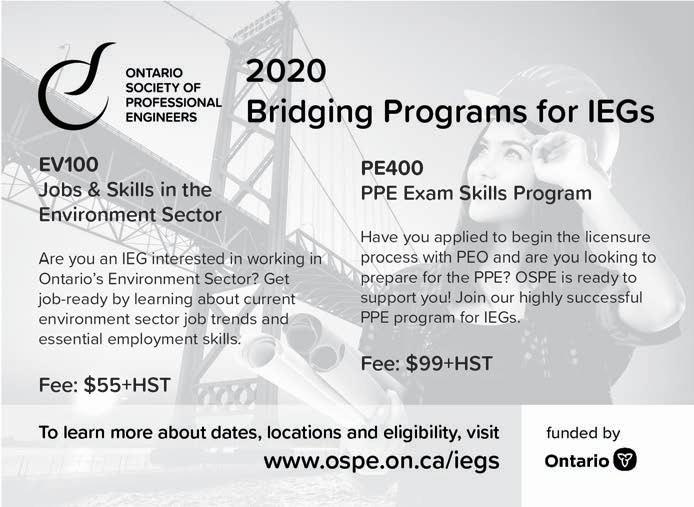
continued from p. 13
steps so that engineering and construction firms engaged in projects with an environmental impact will now have timelines and expectations delivered upfront, early engagement with impacted indigenous communities and federal agencies, increased community input and one assessment and coordination with other jurisdictions. Gamble says that ACEC remains supportive of environmental protection within the framework of a healthy dialogue between the government and business: “Engineers want to be environmentally responsible. We want to do the right things. What we want from the government is clear expectations so we can help our clients address these challenges.”
Gamble also notes ACEC’s concerns with Investing in Canada, a program introduced by the government in 2016, with $180 billion in funding over 12 years, to help municipalities maintain their infrastructure, with an eye on creating long-term economic growth, supporting low-carbon green economies and building inclusive communities. It covers a vast spectrum of programs, from public transit to infrastructure development for rural and northern communities. However, Gambles laments that “the flow of investment has been slower than anticipated.”
Gamble notes that the challenge with programs like Investing in Canada is that the investments are often not evenly distributed through the timeline of the program. When most of the funding doesn’t happen until the later years, it makes it difficult for provinces and municipalities to match the funding and puts a strain on the technological, construction and labour resources. “One of the benefits of a long-term investment is [being able to] to create a level of predictability to make informed business decisions,” Gamble says. “It’s important to evenly distribute [funds] because we now face the prospect of running up a steep hill without knowing what’s on the other side.”
Gamble would also like to see the federal government shift to funding infrastructure from a project-to-project basis to an infrastructure investment program. “We really need to plan the next generation of infrastructure programs, and that is the problem with the Investing in Canada program,” he says. “We told the previous government over and over not to have a gap between programs. It’s the contractors and municipalities who are trying to deliver projects, and they see spikes in investments, only to see the money stop cold.”
ACEC has also been lobbying the government to change its procurement process from one that is cost driven to a qualification-based selection (QBS) procedure. “Public procedure is a stake in the heart of innovation,” Gamble says. “It’s very price focused. You’re not looking at alternatives. It’s very aversive, transferring risk to the proponents. This is not a good environment for trying anything innovative, and the public sector wants to own the intellectual property that’s owned by engineers and architects, yet very often, they don’t understand why they want or need the intellectual property.”
Yet Gamble is optimistic, citing Public Services and Procurement Canada’s pilot control QBS process, with four pilot projects already chosen. “It’s not about giving the job to the lowest price,” Gambles says. “If the lowest price gets the most points, you’re telling the proponents to minimize their level of effort. But if you instead determine
who is the best fit, you can have a talk about the nuts and bolts and the project cost.” Gamble cites jurisdictions, such as some in the United States, where QBS has been implemented into law. Additionally, Gamble asserts that many jurisdictions in Canada are piloting QBS procedures.
ACEC’s lobbying for a QBS procurement process at the federal level echoes the call by CEO to urge the Ontario government and its municipalities to move towards a QBS process. Bruce Matthews, P.Eng., chief executive officer of CEO, told Engineering Dimensions in the fall of 2018, shortly after the election of the Progressive Conservative government of Premier Doug Ford, that “If you spend time and effort in your design, in terms of innovation, you’ll have a piece of infrastructure that will reduce the overall maintenance costs by virtue of its engineering. Is it going to cost a little more at the beginning? Yes, but the overall lifecycle savings will be huge… our members should be chosen on qualification, not on price.” (see “CEO head urges provincial government to prioritize infrastructure spending,” Engineering Dimensions, November/December 2018, p. 10).
By Nicole Axworthy
This year, PEO will induct one Companion, three Officers and eight Members into its Order of Honour (OOH). The Order is an honorary society that recognizes professional engineers and others who have rendered outstanding service through the association. The honorees will be recognized as a ceremony on April 24, held in conjunction with PEO’s 2020 Annual General Meeting in Ottawa, Ontario.
Paul Ballantyne, P.Eng., FEC, will be inducted as a Companion. A PEO volunteer since 1985 and previously inducted as a Member of the OOH, he has a proven record of over 35 years of service and leadership to the profession at all levels of PEO. Serving four years as Algonquin Chapter chair, Ballantyne demonstrated a keen desire to ensure a well-run chapter that fulfilled its mandate. He was fully engaged in local and regional events and continues to mentor new volunteers and new members of the chapter executive. Elected to PEO Council in 2009, Ballantyne also has a long history of service at the provincial level, including serving on the Discipline Committee (DIC), Awards Committee (AWC), and Registration and Central Election and Search committees, and chaired the Advisory Committee on Volunteers and Succession Planning Task Force.
Edward Kai-Jee Poon, P.Eng., will be inducted as an Officer. A Member of the OOH since 2009, Poon has continued his volunteer service at both the chapter and provincial levels. At the chapter level, he has been described as “the master mentor” behind many York Chapter leaders. Similarly, he helped create the chapter’s Past Chairs Advisory Committee—a thinktank for current and future chapter executives—and Engineering Project of the Year Award, which recognizes engineering projects that improve the profession’s image. At the provincial level, Poon has served on the Enforcement, Consulting Engineers Designation and Experience Requirements committees. A devoted supporter of strong governance, Poon also helped organize a York Chapter all-candidates debate in 2016 and 2018 to increase voter participation in PEO’s Council elections.
L. Brian Ross, P.Eng., will be inducted as an Officer. Since being inducted as a Member of the OOH in 2002, Ross has continued his volunteer efforts—especially at the provincial level, where he has served on both the DIC and Professional Standards Committee (PSC), as well as several
PSC subcommittees. As DIC chair, he sought to improve internal processes and chaired a subcommittee that drafted the first DIC handbook. As a PSC volunteer, Ross contributed to committee reviews of subcommittee subject-matter experts charged with preparing draft standards, guidelines and practice bulletins. He also chaired four important PSC subcommittees tasked with developing new guideline materials, including Structural Condition Assessments of Existing Buildings and Designated Structures, Use of the Professional Engineer’s Seal and Conducting a Practice Review
Stephen Hong Tsui, MEng, CEng, P.Eng., FEC, will be inducted as an Officer. Since being inducted as a Member of the OOH in 2003, Tsui has continued volunteering for PEO and the profession. In addition to his role on the WindsorEssex Chapter executive, Tsui has become active in education outreach to local students, mentoring and educating young people about engineering careers. He led the development of the chapter’s successful Innovation Station: Engineering Your Life event, showcasing engineering through events such as popsicle-stick bridge competitions. As a member of the AWC from 2003 to 2018, Tsui was active in engaging chapters in PEO’s awards programs—the OOH, the Ontario Professional Engineers Awards and the G. Gordon M. Sterling Engineering Intern Award—helping to extend recognition to deserving recipients throughout the province.
Karen Chan, P.Eng., FEC, will be inducted as a Member. An active PEO volunteer since 2010, Chan has an outstanding record of volunteer service in the engineering community. Over the last decade, she has held key leadership roles with the Lake Ontario Chapter, including chair, vice chair and secretary. She continues to support chapter activities such as mentoring and social media communications. At the provincial level, Chan served on the PEO/OSPE Joint Relations Committee and PEO’s Public Information Campaign Task Force. She has also worked to increase the impact of events such as National Engineering Month. In this work, she is a visible and highly respected role model for diversity in the engineering profession.
Brett Chmiel, P.Eng., FEC, will be inducted as a Member. Since joining the Mississauga Chapter executive in 2007, Chmiel has strived to raise the chapter’s profile and establish a strong link between the chapter and its members through service in several portfolios, including chapter chair and chair of the Licence Presentation, Engineering Intern (EIT) and Education committees. A passionate booster of the profession among local students, Chmiel helped plan and execute the chapter’s bridge-building and Mathletics challenges for students at area schools while chair of the chapter’s Education Committee. He has also mentored engineering interns and inspired several to follow his lead and serve as Education Committee chair.
Waguih H. EIMaraghy, PhD, P.Eng., FEC, will be inducted as a Member. ElMaraghy is a long-standing PEO volunteer with service on the Academic Requirements Committee (ARC) since 1989. He currently sits as the committee’s vice
chair. Over his three decades on the committee, he has pioneered or been instrumental in many ARC initiatives, including drafting committee policies on conflict of interest and bias and developing and updating the guidelines for assessing and grading PEO applicants’ engineering reports. In addition, ElMaraghy has volunteered with the Canadian Engineering Accreditation Board and the Canadian Engineering Qualification Board.
John Hazel, P.Eng., FEC, will be inducted as a Member. As an Ottawa Chapter leader, Hazel has served in several senior capacities, including chair, vice chair, secretary, privacy officer, webmaster, newsletter editor and chair of the chapter’s Education Outreach, Awards, Events and Communications committees. He has also been active in supporting local education outreach activities. As chair/vice chair of the Education Committee, he is passionate about promoting STEM careers to local students, participating as a judge at the Ottawa Regional Science Fair, acting as an engineer-inresidence at two local elementary schools and organizing numerous National Engineering Month events and activities. As a supporter of the Licensure Assistance Program, Hazel regularly mentors multiple engineering interns in the program.
David Kiguel, P.Eng., FEC, will be inducted as a Member. Currently chair of PEO’s Experience Requirements Committee (ERC), Kiguel’s PEO volunteer history dates to 2004, when he began service as an ERC interviewer and participant in policy meetings. Kiguel has participated in many ERC subcommittees, including chairing the Improved Interviews Implementation Plan Working Group, the ERC Manual Working Group, the Interview Quality Review Group and the ERC Dispute Resolution Board. His ERC policy work has helped develop and improve many applicant guides and documents, as well as PEO’s licensing process. He has also been an active member and supporter of the East Toronto Chapter, delivering technical seminars and licensure-related talks.
Jim McConnach, P.Eng., CEng, FEC, will be inducted as a Member. An active member of the ERC, McConnach has conducted hundreds of experience requirements interviews. His broad knowledge of electrical generation transmission and distribution systems has been helpful in assessing applicant capabilities to provide related engineering services to the public. He has also served on the ERC subcommittee and several task forces and working groups, contributing to several key initiatives, including the ERC Policies and Procedures Manual Task Force and the ERC Review Process Working Group.
Scott Schelske, P.Eng., FEC, will be inducted as a Member. Since starting his volunteer service in 1979, Schelske has served on the Lake of the Woods Chapter executive on and off for over 30 years. He has been a staple at various PEO conferences and congresses over several decades, including organizing six Northern Regional Congresses over the last 13 years. Schelske is also known for mentoring young engineers, ensuring licensure is a top priority for EITs and engineering grads.
Barry Westhead, P.Eng., FEC, will be inducted as a Member. A passionate volunteer for almost 25 years, Westhead has served several elected roles, including secretary, chair
and vice chair for the former Toronto Dufferin Chapter and currently the West Toronto Chapter. He initially joined the Toronto-Dufferin executive in 1993 as education outreach coordinator; was a founding member of PEO’s Engineerin-Residence program, which places engineers in Ontario classrooms; and serves as a senior mentor with the St. Christopher House Engineering Mentorship Program for international engineering graduates. He also mentors young colleagues and volunteers within the West Toronto Chapter.
Nazanin Omrani-Moghaddam, EIT, has been named this year’s recipient of the G. Gordon M. Sterling Engineering Intern Award. As a mining EIT at Newmont Goldcorp in Timmins, Ontario, and as a PEO volunteer with the Porcupine/Kapuskasing Chapter, OmraniMoghaddam has exhibited great leadership potential across many endeavours. A mining EIT since 2015, she is involved in mine planning and scheduling; leading weekly and daily plan meetings with engineers, operation supervisors and mine managers; and directing the operation’s drill and mining activity to achieve production targets. And as an active member of the Porcupine/ Kapuskasing Chapter since 2017, she serves as chapter secretary and education coordinator, demonstrating leadership by organizing events such as the annual scholarship fundraiser, golf tournament and EIT nights. She has promoted the profession by participating in Government Liaison Program (GLP) meetings, attending the 2018 Queen’s Park reception, attending regional congresses and maintaining the chapter’s social media channels. She has been an advocate for women in engineering by co-organizing Girls Expo in Science Timmins 2019—an event aimed at promoting STEM careers among young women students in the community. She continues to show her leadership potential by accepting new challenges and overseeing their execution to successful conclusions that ultimately benefit the chapter and profession.
The G. Gordon M. Sterling Engineering Intern Award promotes leadership development and is available to engineering interns in good standing with PEO’s EIT program. Those chosen for the award demonstrate a commitment to their profession, an interest in assuming leadership responsibilities within it, and a readiness to benefit from a leadership development experience.
By Adam Sidsworth
PEO’s Practice Evaluation and Knowledge (PEAK) program celebrates its third anniversary this month following a recent PEO Council decision to operationalize the program.
At its June 2019 Council meeting, Council voted to move PEAK from being a pilot project, which required PEAK to be reapproved for funding on a yearly basis, to an operational unit status. However, PEAK still remains an annual voluntary program for members. With the continued voluntary status, Ontario is poised to possibly become the lone jurisdiction in Canada without a mandatory continuing professional development (CPD) program for engineers. The latest engineering regulator shifting over to a mandatory CPD program is Engineers and Geoscientists British Columbia, which is working to comply with that province’s Professional Governance Act
PEAK began in March 2017 to help PEO gauge whether licence holders are engaging in and keeping up with CPD. Practising licence holders are asked to complete both an online ethics module and a practice evaluation questionnaire; upon completion of the practice evaluation, they are provided with an individual continuing knowledge target of up to 30 hours each year to voluntarily complete and report to PEO. Non-practising licence holders are asked to declare only that they are not practising engineering and complete an online ethics module. Although PEAK is not mandatory, the completion—or incompletion—of PEAK by licence holders is noted on PEO’s online directory of practitioners, which is available to the public on PEO’s website. PEAK is provided only to holders of a P.Eng. or limited licence; temporary and provisional licence holders are exempt from PEAK, and engineering interns are asked only to familiarize themselves with PEAK in preparation for when they are fully licensed.
With the release of the external review of PEO’s performance as an engineering regulator in June 2019, its lead author, Harry Cayton, international consultant to Professional Standards Authority, forwarded 15 recommendations to PEO, including that “PEO should revise its PEAK program to ensure it is proportionate and outcome focused and achievable by licensed engineers. It should then make participation in this CPD program mandatory for licensed engineers” (see peo.on. ca/sites/default/files/2019-10/PEOReviewReport. pdf, p. 62). Consequently, at its September 2019
#1 PRACTICE EVALUATION
Declaration Questionnaire
#2 ETHICS MODULE #3 REPORTING YOUR KNOWLEDGE ACTIVITIES
Practising U U U U
Non-practising U X U X
PRACTISING: 60 MINUTES
NON-PRACTISING: 30 MINUTES
PEAK process for practising and non-practising members with estimated completion times
meeting, Council endorsed allowing the CEO/registrar to explore how to:
• Seek, with Council’s approval, the legislative framework to implement a mandatory CPD program;
• Create a mandatory CPD program that is measurable and achievable, pedagogically sound and proportionate to maintain the public’s trust; and
• Consult and educate with PEO members about a mandatory CPD program.
Cayton’s recommendation followed a similar call just two months earlier by the coroner’s inquest into the death of Radiohead drum technician Scott Johnson. The April 2019 report urged PEO to “require that all engineers undertake a minimum number of hours of professional development activities and submit a record of such activities each year to PEO” (see “Radiohead coroner’s inquest issues recommendations,” Engineering Dimensions, July/August 2019, p. 19). Additionally, in November 2018, the Ontario Society of Professional Engineers (OSPE) sent a letter to then-Attorney General Caroline Mulroney, noting its concerns about PEO governance and that a “recent review of the [PEAK] program has revealed that fewer than one-third of licensees have fully competed the PEAK questionnaire.”
PEAK’s participation rates have dropped dramatically since it began, with the 2019 participation rate at around half the 2017 rate. PEAK Program Coordinator Arden Heerah, P.Eng., encourages members to participate in PEAK for several reasons, citing that PEAK:
• Publicly posts members’ participation status online for the public, including existing clients, potential clients and colleagues;
2017
March 31, 2017 to March 30, 2018
2018
March 31, 2018 to March 30, 2019
2019 March 31, 2019 to February 29, 2020
• Helps PEO collect meaningful information about members’ practice status and technical CPD efforts;
• Has members address engineering ethics and marries it to regulatory learning; and
• Is quick and straightforward, and PEO provides support to guide members through it.
“PEO continues to hear from employee engineers and employers alike that employers are increasingly tying PEAK to performance reviews,” Heerah says. “And some are using screenshots of PEO’s directory showing their employee engineers’ compliance with the PEAK program in their proposals to prospective clients.” Heerah also asserts that “PEO has heard that some employers and clients express interest in engineers who complete the PEAK program.” To support the growing interest, Heerah continues to provide PEAK presentations, upon request, to chapters, engineering firms, government teams and regulatory advocacy groups.
The PEAK team is available to guide members through the PEAK process by phone at 416-224-1100 or 800-339-3716, by email at peopeak@peo.on.ca, or at the PEAK webpage at peopeak.ca. Requests for PEAK information materials and seminars can be submitted by phone or email.
By Adam Sidsworth
In a move that has been heralded by Manitoba’s engineering and geoscience regulator, the Government of Manitoba announced that it intends to lower the timeframe that civil litigation can be initiated for claims arising from, among other things, negligence or financial loss. Manitoba currently has among the longest limitations of actions periods in Canada.
During his reading of the throne speech for the second session of the 42nd Legislative Assembly of Manitoba on November 19, 2019, provincial Chief Justice Richard J.F. Chartier stated that “amendments to the limitations of actions legislation will…be brought forward to bring Manitoba in line with the rest of the country.” Manitoba currently has a basic limitation period ranging from two to 10 years (two years for claims stemming from torts, including negligence; six years for claims stemming from contracts; and 10 years for claims relating to mortgages and land ownership). It also has an ultimate limitation of 30 years, during which time Manitoba courts may, at their discretion, allow a claim to move forward. Comparatively, Ontario currently has a nearly universal basic limitation period of two years and an ultimate period of 15 years, meaning Ontario engineers could potentially
be held liable for as long as 15 years after their alleged negligence occurred.
Engineers and Geoscientists Manitoba (EGM) Director of Government Relations Scott Sarna says that EGM would ideally like to see the basic and ultimate limitations lowered to two years and either 10 or 15 years, respectively. “We want to fit in with the rest of the country,” Sarna says. “The difference in limitation periods is creating a lot of complications for engineering and geoscience firms to work in Manitoba. And our premier, Brian Pallister, in the 2016 election and in our most recent election, wanted to create competitiveness and ease of movement for goods across the country and eliminate the barriers within the province of Manitoba.” Sarna also cites the government’s May 2018 publication of its Red Tape Reduction Task Force report, with recommendations to reduce barriers for business in Manitoba. The task force
aimed to “identify unnecessary regulatory requirements that have detrimental effects on the competitiveness of business or degrade the quality and availability of community services.”
The announcement comes as EGM is working to make the limitations of actions laws more conclusive for engineering and geoscience firms to do business in Manitoba. Sarna notes that EGM began a limitations of actions task group with members of industry in 2017, and, in consultation with EGM’s legal team, submitted a briefing to Manitoba’s minister of justice in 2018. The briefing, “Proposal to Amend the Limitation of Actions Act,” states that “currently, professional engineers are effectively subject to an unlimited period under the Limitations of Actions Act of Manitoba. Professional engineers under stand and accept that they are accountable for their work under law. However, it is unreasonable for their accountability to go on indefi nitely.” The report also adds that, given the nature of engineering work, “there should be a shift in focus from acceptable performance to other factors affecting the life of engineered work, [such as] ongoing use consistent with the design and proper maintenance… a shorter limitation period is in the public interest because it could serve to encourage owners and operators to take more responsibility for their facilities, products or systems. The original design engineer often has little or no influence on how the engineered facility, prod uct or system is maintained or used.”
Sarna notes that the briefing compared Manitoba with neigh bouring Canadian jurisdictions, many of which have updated their limitation periods within the last 20 years. “We did an environmental scan across the country…and found that we were one of three juris dictions in Canada that had an extended limitations period beyond the 15 years that most provinces have.” Alberta updated its act in 1999 to a two-year basic limitation and 10-year ultimate limitation, while British Columbia, Saskatchewan, New Brunswick, Nova Scotia and Ontario have gradually lowered their limitation periods to twoyear basic limitation periods and 15-year ultimate limitation periods since 2002. The government of Manitoba itself seems to have recognized the need for reform at least since 2010, when the Manitoba Law Reform Commission recommended streamlining its limitation period with the rest of Canada.
By Marika Bigongiari

Sarna suspects that the Manitoba government has delayed shortening the limitations periods because of the all-encompassing nature of Manitoba’s Limitations of Actions Act. “One of the challenges of the statue of limitations is that it includes harassment, bank fraud and other claims,” Sarna says. “And it is a cumbersome piece of legislation. Opening up the legislation could prove difficult for the government because of all the stakeholders that could come out of the woodwork to change other areas.” However, Sarna says, a possible solution would be for the government to provide an exemption to the current limitation periods for engineers and geoscientists to be written directly into Manitoba’s Engineering and Geoscientific Professions Act, similar to other regulated professions—notably Manitoba’s physicians, dentists, chiropractors and public officers—that have two-year basic limitations written directly into their acts. “We’re doing legislative changes anyway,” Sarna says, “so we have asked for exemptions.” However, in the meantime, EGM is meeting with the Winnipeg Construction Association to strategize an approach to the government regarding changes to the Limitations of Actions Act
In an age of increasing interest in safeguarding natural resources and the environment—and considering the burgeoning practice areas of engineering associated with it—Engineers Canada approved its October 2019 white paper dedicated to the topic (engineerscanada.ca/regulatoryexcellence/national-engineering-guidelines/ white-paper-on-environmental-engineering). Several years in development, the White Paper on Environmental Engineering was created by Engineers Canada’s Canadian Engineering Qualifications Board (CEQB) and describes the scope of the unique area of environmental engineering practice. The CEQB is a volunteer-based committee of the Engineers Canada board responsible for providing services, resources and tools to regulators that, among other things, aim to foster excellence in engineering practice.
Christian Bellini, P.Eng., FEC, PEO vice president (elected) and an Engineers Canada director appointed to the CEQB, believes the white paper is a significant achievement and a positive example of an emerging discipline. “The position paper on environmental engineering is a product of a wellassembled CEQB team and a robust consultation process that engaged extensively with practitioners in the field as well as regulators,” Bellini says. “One of the main strengths of this position paper is that it takes a newer engineering discipline and places it in the context of the real world of work.
It recognizes that protecting the environment is a collaboration of the work of engineers and non-engineers. I think this strong message about our collaborative role applies not just to environmental engineering but to a lot of other emerging engineering disciplines as well. It goes a long way to helping the public better understand our role in society as engineers.”
In its definition of scope, the white paper distinguishes between three categories of work: environmental engineering, work that can be performed by engineers and other persons and work that is performed by non-engineers. It further lays out the elements that define environmental engineering and addresses safeguarding the environment and the use of engineering principles. Engi neers Canada hopes that, in addition to assisting engineers and regulators, the paper might also inform government and the public on what environmental engineering entails.
In addition to defining this growing area of practice, the paper provides appendices that offer samples of environmental engineering practice in areas such as site assessment and remediation, water management, air quality management and municipal solid waste management, including definitions of each area; the role environmental engineers play in upholding regulations and protecting the public interest as it pertains to each area; and advice on the codes and standards that are relevant to environmental engineering.
counsel Engineers Canada employed to help with the development of the white paper. “The development of the paper was identified as a priority by the National Discipline and Enforcement Officials Group and the National Practice Officials Group, which are regulators’ staff groups who meet to discuss regulatory issues in their respective areas of expertise,” Ouellette says. “This white paper defines and provides examples of what constitutes environmental engineering in different areas of work. It is meant to support regulators’ staff in their enforcement activities and practitioners in understanding what activities can only be performed by an engineering licence holder so they can report to engineering regulators misuse of the engineering title and unlicensed practice of environmental engineering. It is hoped the paper will support regulators’ enforcement activities in environmental engineering so they can continue protecting public safety in this area.”

Wind power or wind energy involves the use of wind to produce electricity via the same principle that allows airplanes to fly. Wind turbines convert the kinetic energy in the wind into mechanical power. It currently supplies about six per cent of Canada’s electricity demand.

Hans Hillewaert
Self-healing cement utilizes live spores that live in suspended animation, like a packet of dry yeast, until water, permeating through cracks that appear over time, make contact and wake them up. Water causes the spores to grow and produce calcite, filling the crack and preventing it from becoming bigger. Self-healing materials might help structures last longer without requiring significant repairs.
Photo: D Sharon Pruitt
Mélanie Ouellette, manager, qualifications, Engineers Canada, who is responsible for supporting the CEQB, provided advice on the project and managed the contract for the legal
By José Vera, P.Eng., MEPP

In recent years, digital engineering documents have become ubiquitous. For example, some municipalities now accept only digital documents for building permit submissions, including engineering drawings, plans, reports and specifications. Although the use of digital documents comes with several advantages over paper documents—they are easy to access and take up less physical storage space than paper—their use also presents some challenges, such as the risk of unauthorized alteration and potential for digital seal misuse. Consequently, PEO’s practice guideline Use of the Professional Engineer’s Seal requires practitioners who use digital engineering documents to adopt a form of security appropriate for the circumstances.
Below are four commonly asked questions answered through real-life scenarios from practitioners using digital engineering documents. The solutions described here were developed by practitioners who were kind enough to share their methods with PEO’s practice advisory team.
1. How can I verify that the digital engineering document I issued was not altered?
With additional precautions in place, you can ensure that your digital documents are not altered after they have been issued to clients. Consider this scenario: Engineering firm XYZ issues sealed building permit drawings in a digital format to client ABC. Months pass before a building department contacts XYZ to ensure that the digital drawings they received from client ABC are, in fact, the ones that were issued by XYZ and that the digital drawings were not altered in any way.
XYZ has a digital document verification process in place that relies on Secure Hash Algorithms that generate hash values. The hash value is analogous to a digital fingerprint. Even a minor change, such as adding a comma to a digital drawing, will result in a different hash value. Specifically, just before the digital drawings were issued to client ABC, the information technology (IT) department of XYZ generated hash values for each drawing.
XYZ’s IT team finds that the hash values of the digital drawings received by the municipality are identical to the hash values of the digital drawings that were issued to client ABC. Hence, XYZ was able to validate that the drawings were not altered in any way. XYZ has reassured the building department and addressed its concerns. Consequently, the building department can now proceed with approving the building permit. Thanks to XYZ’s preparation, any concerns regarding the authenticity of the digital drawings were promptly and effectively addressed.
2. How can I better protect my digital seal from misuse? One approach is to implement a watermark on digital seals to deter unauthorized copying. Consider this scenario: The Ministry of the Environment, Conservation and Parks (MOECP) contacts engineering firm DEF to confirm that an environmental site assessment (ESA) report, which they received from client JKL in a digital format and that contains the DEF logo, was, in fact, issued by DEF. Furthermore, the MOECP notes that the ESA report contains a digital seal of an engineer named Jane Q.
The engineering manager at DEF is assigned to reply to the MOECP and recalls that there was an engineer by the name of Jane Q working at DEF, but she recently retired and is travelling around the world and is therefore unavailable to confirm that she issued the report. However, the manager checks the transmittal record and confirms that at no time was an ESA report issued from DEF to client JKL. This development leads the manager to inform the MOECP that DEF did not issue this report.
The MOECP accepts the manager’s conclusion that the report was not issued by DEF; nevertheless, the MOECP still wants to confirm if the seal is authentic. DEF has a process in place where all the digital seals of their engineers contain a watermark to deter unauthorized copying of sealed digital engineering documents and their information. Upon review of the ESA report, the IT team at DEF verifies that the seal within the report received by the MOECP does not have such watermark, and therefore could not have been sealed by employee engineer Jane Q.
continued on p. 22
continued from p. 21
The MOECP contacts JKL to inform them that the ESA report in question was not issued by DEF, and after discussions with DEF, the MOECP now has reason to believe JKL used a fabricated seal. Consequently, the MOECP reports this issue to PEO. Finally, JKL is convicted of breaching the Professional Engineers Act by the Ontario Court of Justice and fined for use of a fabricated professional engineer’s seal.
3. My firm uses Notarius in Quebec and DocuSign in the United States; can we use either of them in Ontario?
In short: PEO does not endorse any specific digital signature software. Consider this scenario: Engineering firm GHI is a large transnational firm. The engineering manager at their Ontario office, Michel S., recently read PEO’s Use of the Professional Engineer’s Seal guideline and notes that the guideline requires practitioners to use a form of security for digital engineering documents that, in the judgment of the practitioner, is appropriate for the circumstances. Therefore, Michel S. determines that GHI’s Ontario location should select a digital signature software to comply with this requirement.
Michel S. is familiar with Notarius, which provides digital signatures and is used by GHI’s Quebec office. Furthermore, Michel S. finds out that the US offices of GHI use another product for digital signatures known as DocuSign. Michel S. contacts PEO to determine if GHI can use either of these two products in Ontario.
While speaking with practice advisory staff at PEO, Michel S. learns that PEO does not endorse any specific digital signature software solution. Furthermore, PEO’s position is that practitioners can use any digital signature software that meets the requirements outlined in the Use of the Professional Engineer’s Seal guideline. After reviewing the product specifications, Michel S. concludes that either Notarius or DocuSign will provide an appropriate security method for GHI’s Ontario location.
4. Is there a secure method for digital documents that is completely foolproof?
Often, practitioners will try to find a secure method that prevents inappropriate tampering of digital documents in every possible scenario. However, IT security experts will tell us that no security method is completely foolproof, including the solutions presented in this article. Therefore, practitioners
should place reasonable reliance on the recommendations of IT security experts to minimize the risks associated with using digital engineering documents. Furthermore, there may be better solutions than those presented in this article, or at least solutions more appropriate to the specific circumstances faced by practitioners, meaning there is even more reason to rely on an IT expert.
PEO’s practice advisory team is available by email at practice-standards@peo.on.ca and welcomes questions from practitioners looking for general information on their professional obligations, such as best practices involving the use of digital engineering documents. However, practitioners looking for assistance on specific IT security-related issues should always contact their IT department or their IT consultant, who can best address technical issues involving security of digital engineering documents. e
FURTHER READING “A method for verifying integrity & authenticating digital media,” by Martin Harran, William Farrelly and Kevin Curran, Applied Computing and Informatics, Volume 14, Issue 2, July 2018, p. 145–158, sciencedirect.com/science/article/ pii/S2210832717300753
José Vera, P.Eng., MEPP, is PEO’s manager of standards and practice.
In accordance with section 20 of By-Law No. 1, which relates to the administrative affairs of PEO, the 2020 Annual General Meeting (AGM) of the Association of Professional Engineers of Ontario will be held on Saturday, April 25, 2020, commencing at 8:30 a.m. at the Westin Ottawa Hotel, 11 Colonel By Drive, Ottawa, Ontario. No registration is required.
As noted in section 17 of By-Law No. 1, the AGM of PEO is held for the following purposes:
• To lay before members the reports of the Council and committees of the association;
• To inform members of matters relating to the affairs of the association; and
• To ascertain the views of the members present at the meeting on matters relating to the affairs of the association.
Officers of PEO and other members of both the outgoing and incoming Councils will be in attendance to hear such views and to answer questions. PEO President Nancy Hill, P.Eng., LLB, FEC, FCAE, will preside and present her annual report to the AGM. The president-elect, officers and councillors for the 2020–2021 term will take office at the meeting.
Further information about the AGM, including the procedures for making and addressing submissions at the meeting, will be available on PEO’s website in late March at peo.on.ca/ about-peo/annual-general-meetings/2020-annual-general-meeting.
AprilSaturday, 25, 2020

The Healey Falls Dam on the Trent-Severn Waterway near the town of Campbellford, Ontario, controls the flow of water to facilitate the production of hydroelectric power. It is estimated the facility generates approximately 100,000 megawatt-hours of renewable energy per year.
THE ENERGY SECTOR IS BUZZING WITH ENGINEERS RACING TO DESIGN AND SUPPORT SUSTAINABLE ENERGY OPTIONS AND INFRASTRUCTURE. WE CONSULT WITH THREE ENGINEERING PROFESSIONALS WHO EMPHASIZE THE IMPORTANCE OF DELIVERING ONTARIO’S ENERGY NEEDS THROUGH CLEANER MEANS.
Renewable energy—also known as “green” or “clean” energy—comes from sources that are inexhaustible, such as the sun, wind, rain, water currents or tides and geothermal energy; and given the environmental impact of using fossil fuels, the clean energy sector creates a lot of buzz because of the role it plays in the fight against climate change. In addition to creating more efficient solutions to conserve our natural resources, clean energy also aims to create cost savings for consumers. According to Clean Energy Canada, Canada’s clean energy sector is growing faster than the rest of the country’s economy and is attracting tens of billions of dollars in investment every year, creating jobs in every province and across industries—and Ontario has the biggest piece of the pie, making up 39 per cent of Canada’s clean energy GDP in 2017. Engineers are responsible for many aspects of innovation in this space, including ensuring the requisite infrastructure is in place to meet the province’s energy needs.

—By Marika Bigongiari—
Sometimes progress is about the intermediary steps. Although more sustainable forms of power generation have a clearly positive impact on the environment by reducing our reliance on non-renewable resources, such as coal, oil and natural gas, those non-renewable resources still make up a significant portion of Canada’s energy picture. For that reason, energy waste mitigation initiatives such as carbon capture and storage (CCS) minimize the damage created by using those resources. This is important, especially during the transition to more sustainable methods, explains Marina Freire-Gormaly, PhD, EIT, an assistant professor and researcher in the Lassonde School of Engineering’s department of mechanical engineering at York University. Freire-Gormaly, who holds a master’s degree in the area of carbon management and sequestering carbon dioxide in deep geological formations, is interested in an integrated systems approach to energy sustainability, such as understanding how we can better combine existing and new technologies to more effectively utilize the power, with her most recent work focused on solar photovoltaic powered reverse osmosis water treatment systems for remote and off-grid communities. She has also worked on the pore structure characterization of rocks to study CCS technology, in which carbon dioxide (CO2) is injected into deep saline aquifers for permanent storage. It’s an important intermediary technology that’s sometimes overlooked in favour of greener options, but it’s one that several Ontario energy firms are pushing forward.
CCS involves capturing CO2—either at the source, thereby preventing it from reaching the atmosphere, or by extracting it from the air after it’s been emitted—and then storing it in a secure place, generally deep underground or underwater. Instead of allowing the CO2 emissions to leave the plant through the stack to the atmosphere, for example, the CO2 is first captured, then transported and finally stored underground or in balloons submerged in bodies of water. The underground reservoirs where the CO2 is injected might be unmineable coal seams, depleted oil and natural gas reservoirs or deep saline aquifers, Freire-Gormaly explains.
The practice is not without controversy, with opponents pointing out the environmental risks inherent to transport and storage, stressing the need to abandon fossil fuels altogether in favour of clean energy solutions. However, since fossil fuels remain a significant source of energy in Canada, waste-mitigating technologies such as CCS play an important role in the transition to a clean energy future. CCS takes what is otherwise a waste-producing form of energy and helps shift it towards carbon neutrality. “Carbon capture and storage is considered a sustainable energy technology or a transition technology as we move from a carbon-intensive economy to
renewable power,” Freire-Gormaly observes. “It’s a way to reduce the emissions from conventional fossil-fuel-based energy generation—for example, coal, oil or natural gas power plants.”
According to the Canadian government, CO2 accounts for 80 per cent of greenhouse gas (GHG) emissions produced by Canada, and the majority of those emissions are energy related—so mitigating CO2 emissions due to concerns related to the environment and climate change is becoming an increasing priority. In 2015, the United Nations (UN) General Assembly adopted their 2030 Agenda for Sustainable Development and its Sustainable Development Goals (SDGs)—among them, a stand-alone goal on energy, SDG7, which seeks to ensure access to affordable, reliable and sustainable energy for all. The UN asserts that improved energy efficiency could account for 40 per cent of the emissions reductions needed to achieve their sustainability agenda and the Paris Agreement on climate change.
One of Freire-Gormaly’s recent projects was helping to develop a related report on Canada for the World Bank Readiness for Investment in Sustainable Energy (RISE) project. RISE provides a quick overview of a country’s policies and regulations in the energy sector by assigning a score under three pillars—energy access, energy efficiency and renewable energy—using the standards outlined by the Sustainable Energy for All initiative. Sustainable Energy for All is an international organization with close ties to the UN that works with governments, the private sector and other key groups to drive decisive and swift action towards achieving UN SDG7. RISE assigned Canada an overall score of 90, based on sub-scores of 82 for renewable energy, 86 for energy efficiency and 100 for electricity access.
In the face of climate change, population increases and our need for more energy, Freire-Gormaly maintains that sustainability is critical when considering our energy needs in the long term. “There will be more severe storms, temperatures and eventually climate refugees with mass migrations of people,” she warns. With higher temperatures, we will need more energy to cool our homes and workplaces, and in the case of severe storms, we will need a more resilient electricity grid—and distributed sources of power generation and mitigation technologies can support this. “With mass migrations, we need to be prepared, as a sparsely populated country, to welcome new waves of immigrants and have the capacity in our electricity system to accommodate our energy needs and an industrial sector,” Freire-Gormaly notes.
Hany Farag, PhD, P.Eng., an associate professor in the department of electrical engineering and computer science at Lassonde School of Engineering and principal investigator of the Smart Grid Research Laboratory at York University’s Bergeron Centre of Engineering Excellence, is working in the trenches in the fight to move Canada toward a greener energy future. He’s been developing timely and groundbreaking solutions to address key problems and integration barriers facing energy sector stakeholders, public transit operators and governments. His recent research focuses on the integration of power and natural gas systems, electrification of transportation (e-transport) systems, energy storage systems and smart grids. “Canada’s climate change actions have mandated the urgent need to cut down GHG emissions from the most polluting sectors: energy (26 per cent) and transportation (24 per cent). Increasing the hosting capacity of distributed and renewable energy resources, electrification of transportation and the production of renewable fuel and natural gas have been identified as the key low-carbon solutions to help meet GHG reduction targets,” Farag explains.
The deployment of low-carbon and green technologies is creating a paradigm shift in the way energy is generated, traded, distributed and
utilized. As such, it also disrupts the logistics and operation mechanism of, for example, public bus transit systems and is accompanied by serious technological and economic challenges. “Among these challenges, maintaining the sustainability of low carbon-based energy and transport systems is the most salient,” says Farag, who suggests that power, gas and transport systems could potentially be integrated into a unified framework using renewable energy, electric vehicles and hydrogen generation and storage facilities. “For instance, the surplus of renewable energy resources can be stored in battery energy storage systems or converted using utilityscale electrolysis to hydrogen,” he explains. “Also, hydrogen can be produced from both natural gas and renewable energy and could potentially be utilized to power fuel cell vehicles. Transportation systems could become fully electrified using plug-in electric vehicles or, with the advancement of hydrogen technologies, a mix of fuel cell and plug-in electric vehicles might appear.”
Farag’s current research objectives include the development of an optimization toolkit to design integrated energy systems (IESs), including concurrent design and operation scheduling of IES technologies to minimize GHGs generated by the three integrated systems. Farag says that the toolkit will be used as a decision-making support system to evaluate and enhance the technical and economic aspects associated with the wide adoption of hydrogen infrastructure and quantitatively compare them to their clean counterpart (for example, battery-based storage and plug-in EV technologies). Farag is also working on the development of a distributed communication platform and transactive energy management system, explaining that the decentralized nature of a typical IES structure needs
GfG: gas fired generator
PtG: power to gas
SMR: steam methane reforming
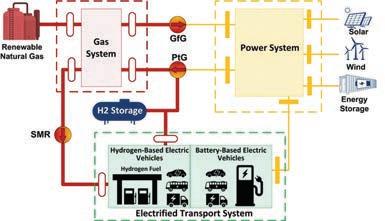
A conceptual diagram of a proposed integrated low carbon/green energy transport system, which the research of Hany Farag, PhD, P.Eng., aims to investigate and advance. The figure shows that power, gas and transport systems could potentially be integrated into a unified framework using renewable energy, electric vehicles and hydrogen generation and storage facilities.
superior distributed communication and control systems. “As such, this objective aims to develop a fully distributed communication platform (DCP) that could enhance message reliability, interoperability and scalability among distributed control units by utilizing Internet of Things technologies,” Farag says. “The DCP will be used to develop a blockchain-based transactive energy system and pricing mechanisms to control and manage IES entities and enhance their resilience by enabling a distributed ledger to maintain ordered time-stamped data blocks that cannot be modified retroactively.” Another objective is shoring up the cyber-physical security of IESs. Farag points out that as the stage is being set for the coordinated operation of integrated low-carbon power, natural gas and e-transport networks, critical operating data and control signals need to be communicated within the integrated systems, in which case, new measures for the cybersecurity of IESs must be developed. Farag aims to identify the issues that might challenge the cyber-physical security of IESs and develop new initiatives to address them. “In this regard, innovative distributed-based solutions will be developed in order to strengthen the capability of IESs to prevent, prepare and respond to and recover from cyber threats,” Farag says.
HYDROPOWER’S
Amidst all the talk about new technologies, hydropower is sometimes forgotten, despite being one of the most well-established and broadly used forms of power today. Hydropower, or hydroelectric energy, harnesses the power of water in motion, such as that flowing through a river, dam or waterfall, to generate electricity by converting the potential energy stored in the water to mechanical or kinetic energy. And even if it doesn’t always come to mind when one thinks of renewable energy, clean energy is exactly what it is, explains Maria El-Zeghayar, PhD, P.Eng., a generation engineer at Portage Power. The fuel that powers hydro, which is the flow of water in the river, is free, and it’s flexible, especially when the upstream reservoir has usable storage. “Hydropower can provide a base load and many grid services like operating and spinning reserves or frequency regulation,” El-Zeghayar says. “It plays a key role in maintaining stable and reliable transmission and distribution networks.”
Canada has a significant installed hydropower capacity, mainly in Quebec, British Columbia, Manitoba, Ontario and Newfoundland and Labrador, she explains. In Ontario, hydropower is the second biggest producer of electricity, after nuclear power. According to Ontario Power Generation, hydroelectricity has a generating capacity of 7475 megawatts produced by 66 generating stations and 241 dams. “Most of these generating stations have been operating for many decades,” El-Zeghayar notes. “More recently, utility scale wind and solar power have been developed across Canada, and we’re starting
“As engineers, we can contribute to the technological development, safe installation and operation and the policies to ensure everyone has access to safe, clean and reliable electricity.”
– Marina Freire-Gormaly, PhD, EIT
to see development of distributed generation and distributed storage. All of these will play a critical role in a sustainable low-carbon future.”
In the hydropower trenches, El-Zeghayar manages the technical aspects of running and maintaining hydropower generating stations and dams, including their design, construction, capital planning, dam safety, permitting and maintenance strategy, and a big part of her work involves respecting and protecting the environment. “We’re committed to building a sustainable energy future that benefits people and the planet through our clean generation practices and communityminded approach,” she says. When building the new Chaudière Falls Expansion, Portage had three goals to meet: produce clean, renewable energy in an environmentally responsible way; be an open public space to be enjoyed by all; and serve as a place of recognition and celebration of Canada’s First Nations and Ottawa’s industrialist past. In addition, the project was designed to have minimal-to-zero impacts on the visual, natural and aquatic environments. “To ensure safe fish passage through our facility, for example, we’ve incorporated leading technological solutions to protect migrating American eel, which are endangered under the Ontario Endangered Species Act (ESA), and facilitate their upstream migration past the numerous hydro-electric facilities at Chaudière,” El-Zeghayar says. “In addition, there are new spawning beds built downstream to promote the recovery efforts associated with sturgeon—also endangered under the ESA.”
The proliferation of distributed energy resources (DERs), or the diversification of where energy is sourced, represents a significant shift in how electricity systems operate. DERs might include a combination of solar panels, electricity storage, natural gas generators or hydrogen fuel cells, for example. Demand-side management, also known as energy management or demand-side response, is the optimization and modification of energy consumption through various methods, including consumer education and financial incentives. Because DERs are generally smaller operations serving smaller geographical areas, El-Zeghayar sees distributed energy resources and demand-side management growing considerably in the near term, which, she says, will bring generation and storage closer to the load, or consumers, eliminating the losses incurred through long-distance travel through transmission lines.
From designing the technology and constructing generating facilities and transmission networks, operating and maintaining assets and running large-scale systems like the Ontario grid, El-Zeghayar says there are places for engineers everywhere: “There are endless opportunities for engineers across the entire technology and asset life cycles related to green energy.” El-Zeghayar reflects on how the work engineers undertake in the energy sector is especially critical in today’s climate: “Sustainability is essential to build a future that is resilient to climate change,” she says. “It is fundamental to the low-carbon future required for the good of the planet and all future generations of life that inhabit it. The costs of wind and solar power are now competitive with the former polluting cheap sources of thermal electricity. The excuses are gone and the time for positive change is now.” e

Nearly half of Toronto residents live in apartment or condo buildings, and in the last 20 years, the city has witnessed the construction of over 1000 new builds—which emit an astounding two million metric tonnes of carbon dioxide every year. In a world where zero carbon is the goal in building design, can retrofitting make apartment infrastructure more sustainable? Engineering Dimensions explores the efforts of Ontario engineers to understand and reduce the environmentally damaging emissions of the city’s big buildings. BY ADAM SIDSWORTH
People understand that vehicles emit carbon dioxide, long suspected of being a major culprit of anthropogenic climate change. And it’s easy to see why: From their tailpipes, vehicles spew polluting gases that are both visible and foul smelling. But few people give thought to the buildings around us. According to The Atmospheric Fund (TAF), buildings in the Greater Toronto and Hamilton Area (GTHA) were responsible for almost 43 per cent of the area’s carbon emissions in 2017, while transportation was only the second-leading cause at just over one-third of fossil fuels. The regional climate agency invests in low-carbon solutions by helping “scale them up for broad implementation” in order to help the GTHA be carbon neutral by 2050. With financial assistance from Natural Resources Canada and the Independent Electricity System Operator, TAF operates its TowerWise retrofit program of multi-unit residential buildings (MURBs) to help achieve a 35 per cent reduction in carbon emissions from large residential buildings in the GTHA by 2030 and meet the city of Toronto’s Green Standard performance targets to reduce buildings’ emissions to near-zero levels by 2030 within the city.
According to TAF, although transportation emissions are derived primarily from diesel and gasoline, “most building sector emissions are from natural gas used for space and water heating,” a fact also asserted by Stephen Kemp, P.Eng., principal and senior energy and sustainability specialist at RDH Building Science Inc. Kemp is an energy efficiency expert, working with architects and developers across Canada on sustainable and high-performance buildings. Kemp focuses on numerous energy technologies, such as geothermal energy, solar power generation and solar thermal. “I think the writing is on the wall that if we’re going to reduce greenhouse gases in Ontario and Toronto by [even] 70 or 80 per cent, it’s not going to get there by more efficient gas systems,” Kemp observes. “Nearly all our operating buildings in Ontario are getting their energy from natural gas, so it’s going to be electrification through heat pumps. There is still undeveloped electricity in Ontario; there’s a ton more that can happen in Quebec and Newfoundland. There will be grid capacity challenges in swing seasons and the challenge that heating energy costs will go up by switching.”
Kemp is adamant that despite natural gas’ much cheaper cost in Ontario—it’s one-fifth the cost of electricity and heat pumps—and given our current infrastructure, making the switch to electricity is the most feasible solution, given that “if you buy a car, it could be smart enough to adjust its burn
for either gasoline or ethanol, but nobody’s doing it for boilers and furnaces,” Kemp says. “And it’s going to take 20 years to install all the flex fuel boilers and furnaces before we can start putting non-methane biofuels in our gas grid.”
Kemp—who is also involved in the industry through participation in the Canadian Energy Efficiency Alliance, International Building Performance Simulation Association and Canada Green Building Council—says that there is no straightforward answer as to whether Toronto is better or worse off with a higher part of its population living in MURBs, given that there is no standard set of metrics to measure a building’s carbon imprint. “If you look at it from an energy use per square metre [perspective], it’s shockingly close to a single-use family home. But you have to ask how you want to measure, and what’s a valid metric? Comparing a single-family home to a multi-unit dwelling probably doesn’t make sense, because the size is so much smaller, and most families probably have one fridge, one stove. You’re spreading that energy use over a much wider area [in a single-family home].” Kemp’s main concern? “In southern Ontario, particularly Toronto, we build a lot of mid- and high-rise multi-unit residential buildings, and they, despite improvements in codes, just aren’t getting much better.”
According to Kemp, the lack of effective insulation in mid- and high-rise MURBs is the main culprit behind their excess carbon leaking. “Most of the condos here in Toronto are built out of window wall,” Kemp explains. “Developers like window wall because you use only one trade to install them—you’re paying one guy to install all that. And that’s a huge cost savings to them.” Window wall—think the floor-to-ceiling window envelopes typically found in newer condos—is achieved by placing glazing and opaque panels between a building’s concrete slabs, using the slabs as structural support. Window walls have a break between the glass, with slab covers used to conceal the concrete. “The newer window wall is becoming very airtight, so it helps you save energy and cut down on drafts,” Kemp concedes, helping the condo have a higher insulation rating. But the window wall insulation is often penetrated by aluminum, which conducts heat 4000 times faster than that of insulation, negating much of the installed insulation values. “Our best double-glazed windows are R3 or R4, compared to our best walls, which could be R20,” Kemp says, referring to the R-value scale of insulation. “A wall beats a window. I’m not sure why the market went this way.”
The other design challenge, Kemp says, are balconies: “We build them as concrete slabs going out the side of the building. It bypasses all the insulation, and heat flows out the weakest link. With our older codes, when we needed only R5, R7 or R10 insulation, these weakest links didn’t matter that much. But now it’s all about those little leaks. If you have an R30 wall against a balcony, that wall is now like an R15 because of the balcony.” Fortunately, there are solutions, notably balcony design details that can significantly reduce the heat loss, such as pre-cast knife edge details, tie-rod details and thermal breaks for traditionally poured concrete cantilever balconies.
Kemp says that more stringent building codes coming into effect— including the Toronto Green Standard, which requires developers to meet certain environmental and energy performance targets before obtaining building permits, and the Leadership in Energy and Environmental Design (LEED) certification system—should encourage

developers to rethink their approaches to construction. “The idea in older codes was that the total energy use of the building has to be less than if it was built to minimum energy code requirements,” Kemps notes. “And so, we have a full trade-off mechanism. You can say, ‘I can get a worse heating system if I had better lights.’ I have all the levers available to us. [We have] better lights because we have LED lights everywhere.” It was this trade-off mechanism that allowed poorly insulated walls to persist in many new buildings. “We’re making it up with condensed high-efficiency boilers. We’re making it up with in-suite heat recovery ventilation—I was a big part of pushing this. My goal was that it improves air quality.”
Toronto’s Green Standard has, according to Kemp, “very aggressive goals so that by 2030, if they stick to their guns, all buildings have to be Passive House performance.” Passive House is a new design standard that results in ultra-low energy buildings that require little energy for space heating and cooling. Kemp has worked on MURBs that meet the threshold of Passive House, including a student residence at the University of Victoria in British Columbia, as well as an upcoming townhome project for the Toronto Community Housing Corporation. “Passive House is coming, and it’s the gold standard,” Kemp says. “Passive Housing mostly says that you get your heating loads to as low as possible, almost to the point where people in the building are enough to provide the heat.” Kemp contrasts Passive Housing with net-zero housing, which aims to reduce a building’s greenhouse gas emissions to an almost zero output. Notably, Kemp has worked on Mohawk College’s Joyce Centre for Partnership & Innovation in Hamilton, ON. Although not a residential building, it is a 96,000-square-foot, zero-carbon institutional building that features a building envelope designed to be as airtight as possible to allow its heating and cooling systems to
A typical post-war apartment tower in Toronto’s Annex neighbourhood. These concrete towers, according to Marianne Touchie, PhD, P.Eng., have their own energy challenges, including fluctuating temperatures and a lack of in-suite temperature controls.
work a minimal amount of time; 1980 solar panels to generate enough energy for 67 houses for a year; and 28 geothermal wells at a depth of 605 feet to allow for a self-sustaining renewable energy source.
But a net-zero building, according to Kemp, isn’t necessarily sustainable in a city as dense as Toronto: “Density is probably good, but once you get past three storeys, you can’t fit the solar panels needed to get to zero on the roof,” he says. “Some jurisdictions are looking at this and saying, ‘You’re not going to put everything on the roof, but how about purchase agreements with an electrical plant out in the suburbs?’ Certainly, from an engineering and building cost point of view, approaching Passive House should be done before you start thinking about where the energy is coming from. Even like Mohawk College, only one-third of the sustainable energy we were able to fit on the building; two-thirds came from solar panels on other building roofs on the campus. And that was a very low-energy building. But at five storeys, it wasn’t going to all fit on the roof.”
“I don’t have a straightforward answer,” says Marianne Touchie, PhD, P.Eng., an assistant professor in the departments of civil and mineral engineering and mechanical and industrial engineering at the University of Toronto. Touchie was asked about the energy performance of newer window-wall residential towers compared to the post-war concrete slabs. According to Touchie, post-war concrete buildings “have smaller windows, maybe a fenestration ratio of 40 per cent or less, and are thermally massive, as they’re constructed from concrete, so they can benefit from thermal lag. But this can also be detrimental,” she says. “For example, in summer the buildings heat up during the day and don’t cool much overnight, so the interior can steadily increase over the course of a multi-day extreme heat event.” Touchie adds that there’s also no in-suite control. “So, while there’s no insulation, during the winter, these units are often overheated,” she explains. Building managers respond to calls that the building is too cold by turning up the heat, causing tenants who complain about the building being too hot to open their windows.
Beyond open windows, Touchie’s research finds that, particularly in older buildings, air leakage is a major culprit in influencing energy performance, particularly around windows, doors, exhaust fans and elevator shafts. Touchie contrasts the old concrete buildings to the newer, window-wall buildings, which, although they are more likely to have in-suite controls, “have a very highly glazed envelope, sometimes with 100 per cent fenestration ratios. That gives the building envelope very little thermal resistance, so you get a lot of heat loss in the winter. But in the summertime, it turns into a greenhouse because of the solar gains.” There are no clear-cut solutions to this design, Touchie says, because it is the result of an interaction between the mechanical system and the envelope.
Touchie’s research focuses on improving the energy performance and indoor environmental quality of existing buildings to make them more comfortable, healthy and sustainable through retrofits, and this often takes the form of monitoring buildings’ energy performance and environmental parameters, such as temperature, relative humidity and air movement. Touchie’s research has focused on conducting MURB retrofits—an often economically unfeasible engineering feat— in a way that’s economically viable for MURB owners. “In a perfect world, you would address everything,” Touchie explains. “You’d look at temperature control and suite-based ventilation strategies,

erly address comfort and energy issues in a high-rise multi-family building. But there are problems with addressing only one of these issues. I’ll give you an example: Adding insulation to the envelope and making the building more airtight can save energy, but if you don’t compensate for the loss of uncontrolled air infiltration, which used to be provided by the leaky windows, with some sort of additional ventilation air, you can get mold growth in the building. Your mechanical and envelope systems have to be working together to make [the retrofit] more effective.”
Indeed, retrofits are, by nature, more economically feasible for rental units, where one owner with access to significant capital can earn larger profits over years from a more energy-conserving building than a condo building, where there is less incentive for a condo board or individual condo owners. And, as Kemp points out, you have “large, informed players with a lot of properties” with the capital to do retrofits, as opposed to “mom and pop owners…who don’t have access to capital.”
Touchie’s research has focused less on large, macro-level retrofits and more on small-scale economically viable projects to improve MURBs’ energy performance. At TAF, Touchie worked on a project retrofitting seven post-war social housing projects. One of the chosen retrofits was the installation of thermostats in individual units. The buildings, all owned by Toronto Community Housing, rely on ventilation through the building envelope, an ineffective method. According to Touchie, TAF is now in the process of analyzing the data, which was collected between 2014 and 2015,

According to Stephen Kemp, P.Eng., windowwall residential buildings (left) are favoured by developers because they are cheaper to build, despite being extremely energy inefficient. For efficiency purposes, Kemp would prefer they be built more like the building on the right.
looking at, among other things, energy consumption, temperature, humidity and carbon dioxide concentration in more than 70 apartment units. Touchie conducted a similar but more recent project with Helen Stopps, who was at the time one of Touchie’s PhD students. The duo is implementing occupancy-based thermostats into several units of two downtown Toronto condo towers built in 2014. “Most new buildings are built with non-programmable thermostats,” Touchie explains. “And our question was: Could a low-cost thermostat at between $200 and $300 have an impact if it’s deployed across an entire building? Because, obviously, you’re not going to be spending tens of millions of dollars retrofitting a building that was just built. Is there a way to improve the performance of these buildings that is a lot quicker and cheaper?”
Touchie’s thinking is that with an occupancy-based thermostat that lowers a unit by a just a couple of degrees when the occupants are away and raises it when they’re at home without relying on occupants’ having to remember to adjust the temperatures, buildings’ carbon impacts may improve. “Some of the preliminary findings suggest a savings of somewhere between 8 and 17 per cent, switching from a non-programmable thermostat to an occupancy-based thermostat,” she says. “We’re still working on the data processing, so that data may get refined a little more.” But Touchie is interested in being able to expand to analyze an entire building’s performance, rather than a unit-by-unit basis. “Building the impact of randomness on the entire system is what we’re looking at right now,” she explains.
Touchie would like homeowners in Ontario and Canada to take more seriously the carbon impact of their properties. “I feel like people do more research on the next cell phone they’re buying, compared to the condo they’re buying,” she points out. “It’s the biggest investment of people’s lives. You’re making these split decisions [with] no inspection: ‘I’m just going to put down hundreds of thousands of dollars without thinking about the impact it’s going to have on my life.’” Ideally, Touchie would like Ontario to adopt the rules of many jurisdictions in Europe, where “every time you buy or sell a property, you have to disclose an energy performance certificate, which rates [your home] on a scale and gives it a grade on how well it performs on an energy grade. Once purchasers have access to that data, it’s something they can consider when purchasing a property. When purchasers are aware of the impact that this has environmentally and financially, they go into it with a whole different set of demands.” e
APRIL 1–3
2020 Mach Conference, Annapolis, MD machconference.org

APRIL 1–2
f-cell+HFC 2020: The Hydrogen and Fuel Cell Event, Vancouver, BC chfca.ca/updates/events


APRIL 2
Design Engineering Expo, Abbotsford, BC dexexpo.com
APRIL 7–8
T T TCanadian Sustainability Conference, Toronto, ON sustainabilityconference.ca
Soft Skills Engineering
A weekly podcast offering advice for software developers softskills.audio
The Engineering Career Coach
A podcast from the Engineering Management Institute about management and people skills training for engineers by engineers engineeringmanagementinstitute.org/ the-podcast
SEI Podcast Series
APRIL 20–23
IEEE International Systems Conference, Montreal, QC 2020.ieeesyscon.org
APRIL 24
APRIL 25
PEO Annual General Meeting, Ottawa, ON peo.on.ca
APRIL 20–24
International Conference on Performance Engineering, Edmonton, AB icpe2020.spec.org
PEO Order of Honour Gala, Ottawa, ON peo.on.ca
APRIL 26–29
Canadian Conference of Electrical and Computer Engineering, London, ON ccece2020.ieee.ca
How Does the Power Grid Work?

A look at the infrastructure that powers our energy needs youtube.com/watch?v=v1BMWczn7JM
Why Build Higher?
An exploration of the trend to builder taller buildings youtube.com/watch?v=3qLsPHz_Hr8
Why Do Backwards Wings Exist?
A look at why some planes were designed with backwards-facing wings youtube.com/watch?v=RN6vGxyMcVU
A podcast from the Software Engineering Institute covering software engineering, cybersecurity, artificial intelligence engineering and future technologies sei.cmu.edu/publications/podcasts
Future Tech Health
A podcast covering the latest in bio-engineering, from medicine to stem cell technology futuretechhealth.com
Renewable Energy: A Primer for the Twenty-First Century, by Bruce Usher, 2019: A comprehensive look at the implications of accelerated growth in renewable energy for industries, countries and the climate and the needed preparations for the changes ahead as we move away from fossil fuels
Sustainable Construction: Green Building Design and Delivery, by Charles J. Kibert, 2016: A green building reference covering the latest advances in sustainable construction, including architecture and engineering, with detailed information on all aspects of the green building process, from materials selection to building systems
Renewable Energy: Power for a Sustainable Future, by Stephen Peake, 2018: A look at the practical and economic potential of renewable energy sources and the challenges of meeting a growing demand for them
By Marika Bigongiari
In April, the Engineering Institute of Canada (EIC) will induct 22 new fellows at an awards gala in Ottawa. The appointments honour exceptional contributions to engineering across Canada. The 2020 inductees include Michael Cunningham, PhD, P.Eng., professor and Ontario research chair in green chemistry and engineering, Queen’s University; Nazir P. Kherani, PhD, P.Eng., professor in the departments of materials science and engineering and electrical and computer engineering, University of Toronto (U of T) and a former recipient of an Ontario Professional Engineers Engineering Medal in Research and Development (2009); David Poirier, P.Eng., founder and CEO of The Poirier Group; Douglas Reeve, PhD, P.Eng., professor of chemical engineering and applied chemistry, U of T, and founding director of the Troost Institute for Leadership Education in Engineering; Craig Simmons, PhD, P.Eng., professor in the department of mechanical and industrial engineering, faculty of dentistry and the Institute of Biomaterials and Biomedical Engineering, U of T, and scientific lead for the Ted Rogers Centre for Heart Research; Susan L. Tighe, PhD, P.Eng., deputy provost and associate vice president, integrated planning and budgeting, and Norman W. McLeod professor in sustainable pavement engineering, University of Waterloo; Xianbin Wang, PhD, P.Eng., professor in the department of electrical and computer engineering and Canada research chair in 5G and wireless IoT communications, Western University, director of the Innovation Centre for Information Engineering and director of the Natural Sciences and Engineering Research Council’s CREATE Program in Communications Security, Privacy and Cyberethics; and Fei Richard Yu, PhD, P.Eng., professor, department of systems and computer engineering and the School of Information Technology, Carleton University. The EIC’s mission is to develop and promote continuing education, initiate and facilitate interdisciplinary activities and services, lead member societies in defining and building the future of engineering and advocate the values and benefits of engineering.
Shiva Kumar, PhD, P.Eng., professor of electrical and computer engineering, McMaster University, has been elected as a fellow of the Optical Society. Kumar is an expert in fibre optic communication systems and was recognized for his significant contributions to this area of study. He is the first member of the McMaster community to receive this honour.

Douglas Reeve, PhD, P.Eng., professor of chemical engineering and applied chemistry at the University of Toronto and director emeritus of the Troost Institute for Leadership Education in Engineering, will be inducted as a fellow of the Engineering Institute of Canada.
U of T Engineering/Mark Balson
Mariko Shimoda, a fourth-year mechanical engineering student at the University of Waterloo, has been named a community leader by the university in recognition of the impact she has made on her community.
Mariko Shimoda, a fourth-year mechanical engineering student at the University of Waterloo, has been named a campus Community Leader in recognition of the phenomenal impact she has made on her community. Shimoda, who is active in both the faculty of engineering and the Waterloo Undergraduate Student Association, has led outreach programs for young students at Kitchener’s THEMUSEUM and developed a mental health resource kit. She also lends her assistance to the Food Bank of Waterloo Region, participates in the Toronto Pride Parade and is passionate about supporting girls in STEM.
Lianna Genovese, a third-year McMaster University biomedical and mechanical engineering student, has won a prestigious Real Impact on Society and Environment (RISE) award from Universitas 21 (U21). Genovese received the Most Innovative award for her project

Guided Hands, which helps people suffering from reduced fine motor skills and a range of physical challenges to write, draw and use a tablet or computer using a 3D-printed ergonomic handpiece. Genovese, who plans to commercialize the design, previously won first place in a Universities Canada competition for innovative design for accessibility as well as a people’s choice award at Innovation Factory. RISE is U21’s newest student opportunity, an international showcase of student achievement in sustainability and social innovation designed to accelerate the scale and impact of student-led
projects by connecting them with a network of experts in academia and industry.
U of T PhD candidate in civil engineering Myron Chiyun Zhong has won the Pacific Earthquake Engineering Research Center’s Blind Prediction Contest, which recognizes submissions that best predict the results of an earthquake. Zhong, who competed against 13 teams from 10 countries, submitted the most accurate prediction for an earthquake model based on shake table results. Blind prediction of earthquakes is related to Zhong’s PhD research, which includes developing and validating a novel self-centred structural system that can be applied to high-rise structures that may be vulnerable to severe wind or earthquake events. e
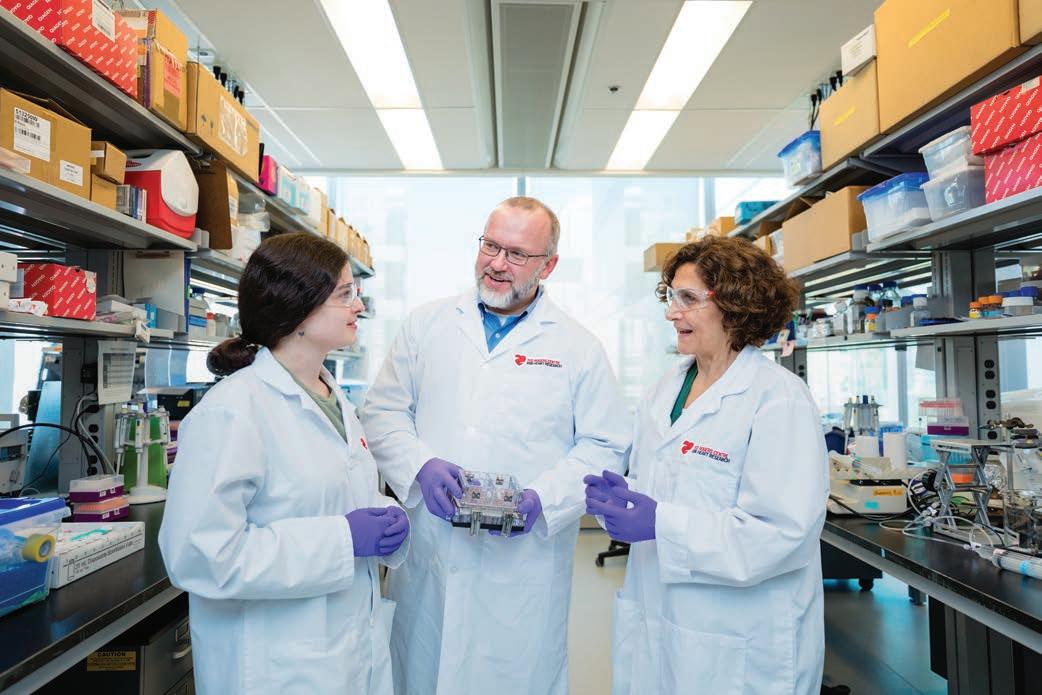
University of Toronto Professor Craig Simmons, PhD, P.Eng. (centre), who is shown collaborating with his associates at the Ted Rogers Centre for Heart Research, is to be inducted as a fellow of the Engineering Institute of Canada as part of their 2020 cohort.
Photo: U of T Engineering/Neil Ta
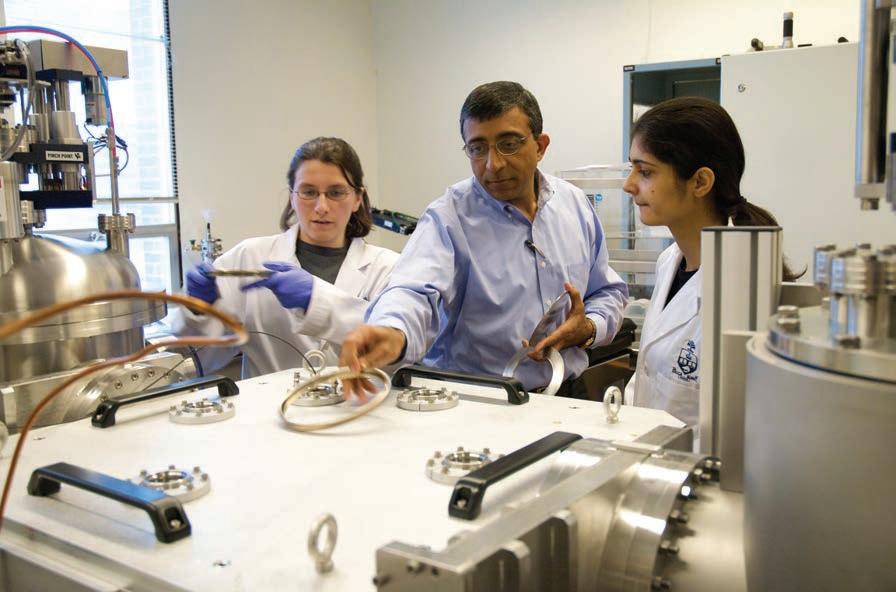
University of Toronto Professor Nazir P. Kherani, PhD, P.Eng. (centre), who is shown engaging in discussion with two students, will be inducted as a fellow of the Engineering Institute of Canada.
U of T Engineering/Mark Balson
By Howard Brown and Stephanie Gomes
Over the years, much has been written about PEO’s Govern ment Liaison Program (GLP) since the initiative launched in 2005. The program began in response to the Ontario government’s building code changes, which challenged PEO’s jurisdiction over the practice of professional engineering.
One activity that has been quietly existing within PEO’s chapter system is the regional GLP academies and congresses. Over the last nine years, PEO chapters have hosted over 30 day-long government relations training sessions featuring ministers and MPP guest speakers to help PEO and its members learn how to interact with government, with the aim to avoid similar jurisdiction disputes in the future. “The purpose of these GLP regional academies and congresses is to train and educate our chapter representatives on how to do government relations and develop relationships with their local MPPs,” says Jeannette Chau, P.Eng., PEO manager, government liaison programs. “At the same time, I believe they help give MPPs a greater awareness of PEO and educate them on the roles and responsibilities of PEO as a regulator.”
The first GLP academy was held in Hamilton in 2011, organized by then Hamilton-Burlington Chapter GLP chair (and current Western Region Councillor) Wayne Kershaw, P.Eng. He thought it was important to have a meaningful day-long discussion with chapter members interested in government relations. “I did this because I thought the timing was important,” Kershaw says. “The GLP program had been in place for a number of years, and I thought we needed something to really engage with MPPs in a more substantial way. We wanted to give MPPs a more coherent and unified message.”

Affairs and Housing Minister Steve
The event targeted PEO’s Western Region, and the guest speaker was former Ontario finance minister Greg Sorbara. Sorbara drove for two hours through a snowstorm to Hamilton to share with GLP representatives how important he believed their roles were as a local connection to MPPs and in helping PEO be a better regulator.
Subsequent GLP academies have been held in all regions across Ontario, in cities such as Thunder Bay, Sudbury, Timmins, Windsor, London, Cambridge, Goderich, Kingston, Gananoque, Ottawa and Toronto. At the four academies that were held in 2019, at least one MPP or minister from all political parties participated as guest speakers. At the Eastern Region Academy and Congress in November 2019, Ontario Minister of Municipal Affairs and Housing Steve Clark told PEO GLP representatives, “I believe PEO has the best government relations setup of any group in government, bar none.” He also told the audience: “It’s very important to be able to have that local face-to-face time. And the beauty of PEO is that you’ve got so many great ambassadors in local ridings to begin with—and I have met with many of them over the years.”
The strength of PEO’s GLP academies is that representatives can engage in discussion on PEO’s regulatory responsibilities with their local MPPs and obtain individual government relations training. Importantly, it provides an environment to create and strengthen PEO’s message. The GLP academies provide PEO members with tools to ask important questions, to know what should be on their agenda in a conversation, and to feel comfortable going to their MPP and sharing information about what they do as a member of PEO. They learn more about the background of their local MPPs, such as talking points, procedures, reporting and responsibilities. Additionally, having MPPs present for these discussions allows government representatives to report back to their parties and continue the conversation in their caucuses. As they say, all politics is local, and through the GLP, PEO is able to leverage its local connections. e
Howard Brown is president of Brown & Cohen Communications & Public Affairs and PEO’s government relations consultant. Stephanie Gomes is Brown & Cohen’s account executive.
By Nicole Axworthy
At the February Council meeting, the activity filter’s progress report was presented to Council by General Counsel Daniel Abrahams, LLB. He updated councillors on the process by which staff recently worked to apply the activity filter to 93 key, high-level activities of PEO committees, subcommittees, chapters and working groups.
The need for an activity filter forms part of the high-level action plan that was approved by Council in September 2019 (see “Council approves action plan to implement recommendations of external review,” Engineering Dimensions, November/December 2019, p. 50). Each activity and its related output(s) were assessed for their legal basis to determine if they are required or permitted under PEO’s current legislative scheme or by law. The activities were then divided into three groups: regulatory activities, governance activities and activities that are neither regulatory nor governance.
PEO’s CEO/registrar and senior staff will now work to develop recommendations for the assignment of responsibilities for outputs to either Council or the CEO/registrar and report the results to Council at an upcoming meeting. For activities with outputs that fall within the CEO/ registrar’s domain, they will develop appropriate reporting metrics and propose them to Council; and for activities with outputs that do not fall within the CEO/registrar’s domain, they will generate options for Council to consider with respect to whether the activity should be continued, how it should be continued and who should perform the activity.
Council approved a motion to amend the Council meeting minutes from its September 2019 meeting that relate to item 2.15 (membership referendum on PEAK). The revised minutes were developed by Councillor Keivan Torabi, PhD, P.Eng., and staff to read:
Following the introduction of the motion for a membership referendum on the PEAK program, Councillor Brown objected to Council considering the motion reasoning it was premature to discuss the motion in light of the pending work to be done related to the results of PEO’s external regulatory performance review. Councillor Brown then introduced a new motion to determine if Council should consider the motion on the PEAK membership referendum. That Council shall consider discussing the motion on holding a membership referendum on the PEAK program. DEFEATED
In reviewing the minutes of the meeting and the subsequent coverage in Engineering Dimensions (November/December 2019, p. 51), Councillor Torabi felt that they did not capture the discussion held by Council. The minutes suggested that Council defeated a motion to hold a member referendum when, in fact, Council did not vote on the main motion to hold a PEAK referendum. Instead, it voted to have the main motion removed from the table and agenda, as put forth by Past President David Brown, P.Eng., FEC, BDS, C.E.T. Council voted against discussing the motion on holding a membership referendum on the PEAK program, and it was therefore removed from the table and agenda.
At the February meeting, Council was asked to approve the Indigenous Land Acknowledgement Policy presented to Council and initiate the recitation of the statement at the start of all events held at PEO’s headquarters; approve the invitation of Indigenous leaders to attend PEO’s Council meetings and the upcoming annual general meeting on April 24–25, 2020; and direct PEO chapters to make a land acknowledgement statement at the start of their events once the appropriate indigenous nations have been identified and approval received. At its meeting in June 2019, councillors agreed to pursue a white paper on the need for a PEO policy on Indigenous land acknowledgement, as submitted by President Nancy Hill, P.Eng., LLB, FEC, PresidentElect Marisa Sterling, P.Eng., FEC, and Northern Region Councillor Ramesh Subramanian, PhD, P.Eng., FEC. Following completion of the policy work, Council was now being asked to consider the policy. A full discussion ensued, with some councillors fully supporting the motion while others had concerns about the need for meaningful consultation and whether it was relevant to the regulation of professional engineering. Councillor Marilyn Spink, P.Eng., put forward a motion to postpone the original motion until after Council has a strategic planning session. Council voted in favour of the new motion.
Council discussed a memo from Engineers Canada regarding a change in an Engineers Canada bylaw that sets the per capita assessment fee for regulators. Currently, PEO and all other Canadian engineering regulators give $10.21 per registrant on an annual basis to partially offset the operating expenses of Engineers Canada.
At the Engineers Canada February 26 board meeting, the board was asked to consider a proposal suggesting that Engineers Canada recommend to its member regulators a change to its bylaw to allow the amount levied to be approved annually by the regulators at its annual meeting of members starting in 2022. This would allow regulators to have a direct say in the size of the proposed budget for Engineers Canada by determining, on an annual basis, the amount of regulator revenue that will be made available. The new bylaw change will be put before Engineers Canada’s meeting of members in May. e






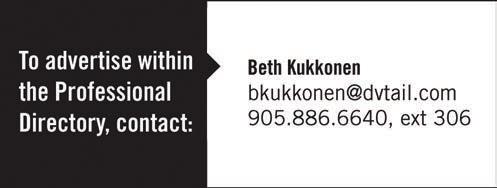
PEAK should be revisited
Anthony Vlassopoulos, PhD, P.Eng., PMP, Toronto, ON
I am not surprised that Council defeated a motion to hold a member referendum on PEO’s Practice Evaluation and Knowledge (PEAK) program (“Council approves action plan to implement recommendations of external review,” Engineering Dimensions, November/December 2019, p. 51). The program would likely not pass the test, and not because our members shun accountability. It’s because, in its current form, it seems draconian and punitive. It should be supportive instead. It may also miss the target as, time and again, we see that members who do
EDITOR’S NOTE: In the article covering PEO Council’s September 2019 meeting, we incorrectly worded the outcome of Council’s vote on the motion to hold a PEAK program referendum. In fact, Council did not vote on the main motion to hold a PEAK
wrong by the public and who are sanctioned by our association do so knowingly, not due to incompetency.
Other bodies are doing a good job at testing the skills and character of their members. One instance with which I am familiar is the continuing certification process for project management professionals of the Project Management Institute. Now that we have experienced the reception of the first PEAK, perhaps it’s worth taking another, closer look elsewhere.
George Prentice, P.Eng., Owen Sound, ON
referendum. Instead, it voted to have the main motion removed from the table and agenda. Council voted in favour of the motion to remove it from the table and agenda. (See Council minutes amendment on page 36 of this issue.)
codecad.com
Further to letters published from David Hogg, P.Eng. (“Longstanding members deserve life member status,” Engineering Dimensions, September/October 2019, p. 38), and M. Gordon Farr, P.Eng. (“Members should be afforded life member status,” January/February 2020, p. 58), I partially agree with their request regarding fees for registration for us retired engineers, except that a reduced minimum fee could be set. Maybe an application could be established for those who require/request relief in order to maintain membership and interest in our association. Consideration should be given to years practised as a registered/ licensed P.Eng., involvement and contributions to PEO.
Manulife p. 39 manulife.ca/dimensions
Ontario Society of Professional Engineers p. 13 ospe.on.ca
LETTERS TO THE EDITOR are welcomed, but must be kept to no more than 500 words, and are subject to editing for length, clarity and style. Publication is at the editor’s discretion; unsigned letters will not be published. The ideas expressed do not necessarily reflect the opinions and policies of the association, nor does the association assume responsibility for the opinions expressed. Emailed letters should be sent with “Letter to the editor” in the subject line. All letters pertaining to a current PEO issue are also forwarded to the appropriate committee for information. Address letters to editor@peo.on.ca.
about Engineers Canada-sponsored insurance plans

Over 90,000 of your peers and their families enjoy these benefits. You can, too.
Here are more key facts about these valuable plans:
You have exclusive access to insurance plans created specifically for engineering professionals.
Engineers Canada and Manulife continually assess the plan benefits and rates to ensure they’re highly competitive.
They’re innovative, with recent enhancements like the job loss waiver of premium – the first of its kind in Canada.
Learn more about how these plans can benefit you.
manulife.ca/dimensions 1 877 598-2273
Engineers responsible for certificates of authorization: Have you done your PEAK elements?

Show the public, your colleagues and clients you’re committed to competence, professionalism and transparency. The PEAK program helps you and your firm publicize your efforts to stay current in your practice and knowledgeable about your ethical obligations.
After you get your licence renewal notice, log into the member portal on PEO’s website and start at the PEAK menu tab. Your PEAK completion status and practising status are posted online on PEO’s directory of practitioners.